Indian Gastronomy (Pt. 2 - Western India)

Indian gastronomy is one of the most influential cuisines on the planet. Thanks to the geographical variety and heavy uses of spices, the breadth and complexity of flavor of Indian food is absolutely incredible. From curries and breads, to lentils and stews, to heat galore, it is no wonder why Indian food is one of the most popular and beloved cuisines of all time.
India is one of the largest and most diverse countries in the world. Due to its sheer size, extreme regional variation, and depth of gastronomy, reviewing all of India in a single article would be completely overwhelming. India is most colloquially grouped together as North India and South India. Officially, it is divided into 6 zones: Northern, Central, Eastern, North Eastern, Western, and Southern. For the purposes of these gastronomy reviews, we will talk about India in 4 parts: Northern/Central, Western, Southern, and Eastern/North Eastern.
In Pt. 2, we will review Western Indian cuisine. West Indian cuisine is known for its chaats/snack foods, and coastal cuisine. These seafood from Mumbai/Bombay and Goa are some of the best meals to get when in the region. Additionally, the impressive number of yummy snack options is what many people think of when they think of West Indian food.
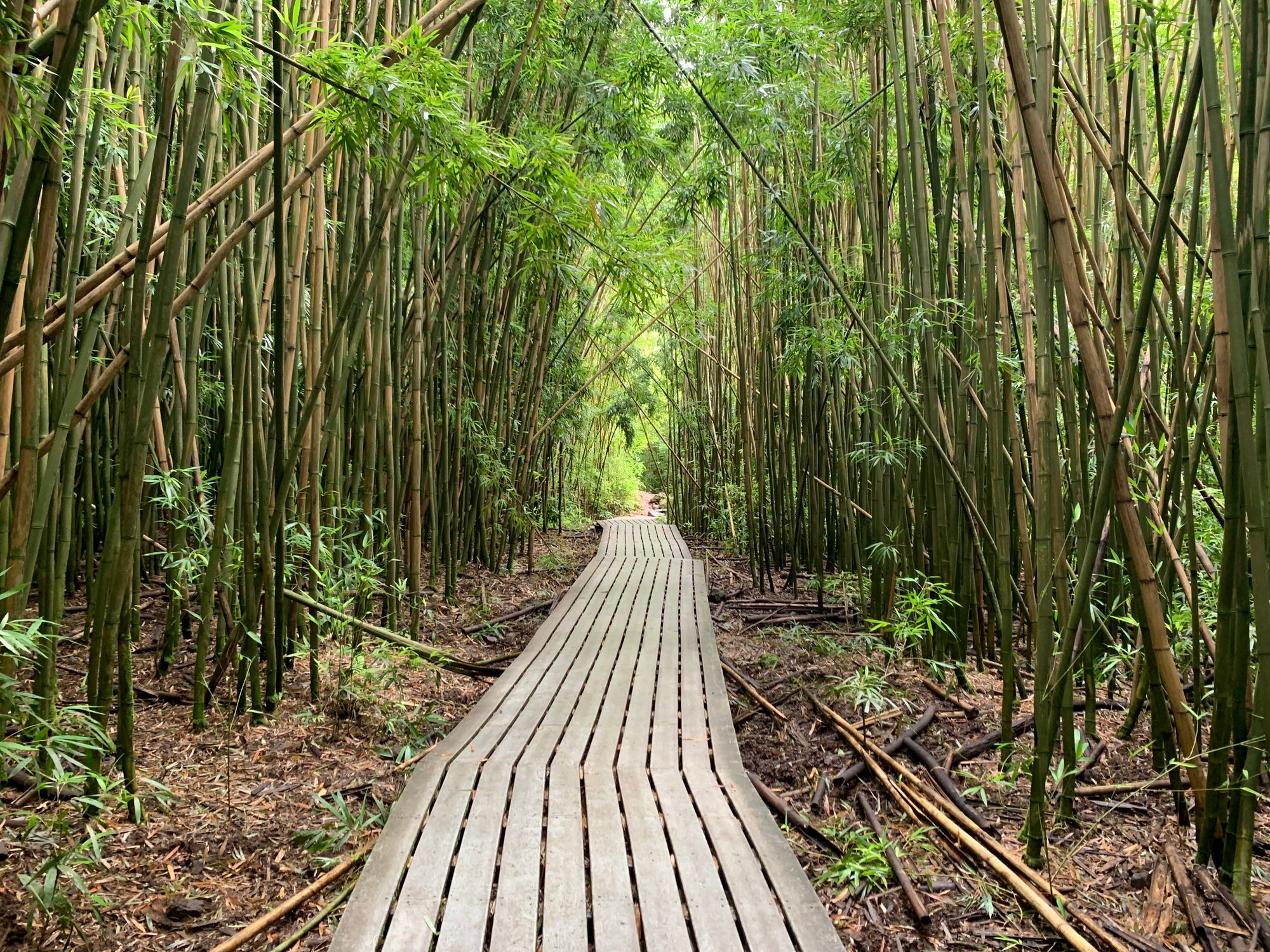
Culture and Geography
History
India is one of the powerful ancient civilizations, having been around since the transition to agriculture thousands of years ago. India began with varying rules and dynasties primarily within the sub-continent: starting with the Vedas from Central Asia / Punjab, the Maurya Empire from Northern India, followed by the famous Gupta Empire, ending with the Tripartite struggle in the north and a series of empires (most notably the Chola) in the south. I say "ending" here not by any means because Indian empires and dynasties stopped in the 13th century with the decline of the Chola, but because this is when the subcontinent's primarily self-contained struggles are introduced to overwhelming external influences.
India had been trading and having a profound impact on the Middle East for most of the classic and medieval periods. The Middle East reciprocated this impact on India in a much more drastic way starting in the early modern era. Islamic conquests of Northern India began around the 13th century. These were held off by a resurgence of powerful Hindu states like Mewar in Rajasthan, but by 1556 the Mughal Empire had officially established rule in India. It was during this time that India received a large dose of Middle Eastern / Persian influence. Most of North Indian cuisine is based on the intermingling of these two major cultures during this period. New sets of ingredients, a shift towards rice as a staple of the Indian gastronomic identity, and the introduction to a wide variety of milk-based sweets completely morphed Indian gastronomy into what it is today.
India eventually ousted the Mughal Empire from its long rule, only the be replaced by the British shortly after. At the beginning of the colonial period, it was the Portuguese who had first established trading posts in India, most notably Mumbai/Bombay, and a territory in Goa. Additionally, the Dutch and the French also began to develop territories in India, but these territories were limited in scope and influence. While the Portuguese have significantly influenced the cuisine and culture of Western India, the East India Company, aka the Great British Empire, was the predominant colonial force in India. The British came to rule almost the entirety of India/Pakistan for hundreds of years (over a hundred years of partial rule, with a period of direct rule under the British Raj from 1858 to 1947). They brought tons of new ingredients from the Americas to finish enriching Indian gastronomy to its modern form. Finally, India gained its independence in 1947, splitting with Pakistan, and has remained that way since.
Regions
The regions that define Western India are Dadra and Nagar Haveli and Daman and Diu, Goa, Gujarat, and Maharashtra. Goa is known for its coastal seafood and large Portuguese influence. Gujarat is known for its snack food. Maharashtra is extremely influentiall because it contains Mumbai/Bombay.
Regions
Dadra and Nagar Haveli and Daman and Diu
Goa
Gujarat
Maharashtra
Ingredients
India has one of the world's largest ingredient list, as a key feature of the cuisine is spices. As can be seen below, there are so many spices in the Indian kitchen, and they are used in everything. An important note would be masala. Masala, translated as "spices", refers to a specific mix of spices that is used frequently in many dishes.
Most famously for Western Indian food, Chaat Masala is a tangy spice blend that includes amchoor (dried, unripe mango), as well as a combination including some of the following: asafetida, mint, ginger, ajwain, cayenne, black salt, black pepper, cumin, coriander, and pomegranate seeds.
Major Spices
Garam Masala
Chaat Masala
Ajwain
Amchoor (dried mango powder)
Asafetida
Cardamom
Coriander
Cumin
Curry Leaves
Dried Chiles
Indian Bay Leaves
Fennel Seeds
Fenugreek
Mustard Seeds
Tamarind
Turmeric
Star Anise
Beans and legumes are popular throughout India. Lentils, black lentils, chickpeas, split yellow pigeon peas, and mung beans are popular protein sources in many dishes throughout India. Obviously, sitting between the North and South geographically, mixed characteristics of both Northern and Southern Indian food can be seen in West Indian cuisine (the line between the these things of course blurs as we make grouped distinctions for a fluid concept); for example, we see a nice blend of breads and rice-based dishes in West Indian foods, somewhat of a compromise between North and South Indian cuisines. Chaats/snack foods and the coastal cuisine of Mumbai/Goa are for what Western Indian food is mostly known.
Major Ingredients
Lentils
Chickpeas
Mung Beans / Green Gram (called Mung Dal)
Black Lentils / Gram (called Urad beans)
Split Yellow Pigeon Peas (called Toor dal)
Ghee (clarified butter)
Achaar (Indian pickles)
Mustard Oil
Yogurt
Paneer
Basmati Rice
Seafood
International Highlights
Vindaloo
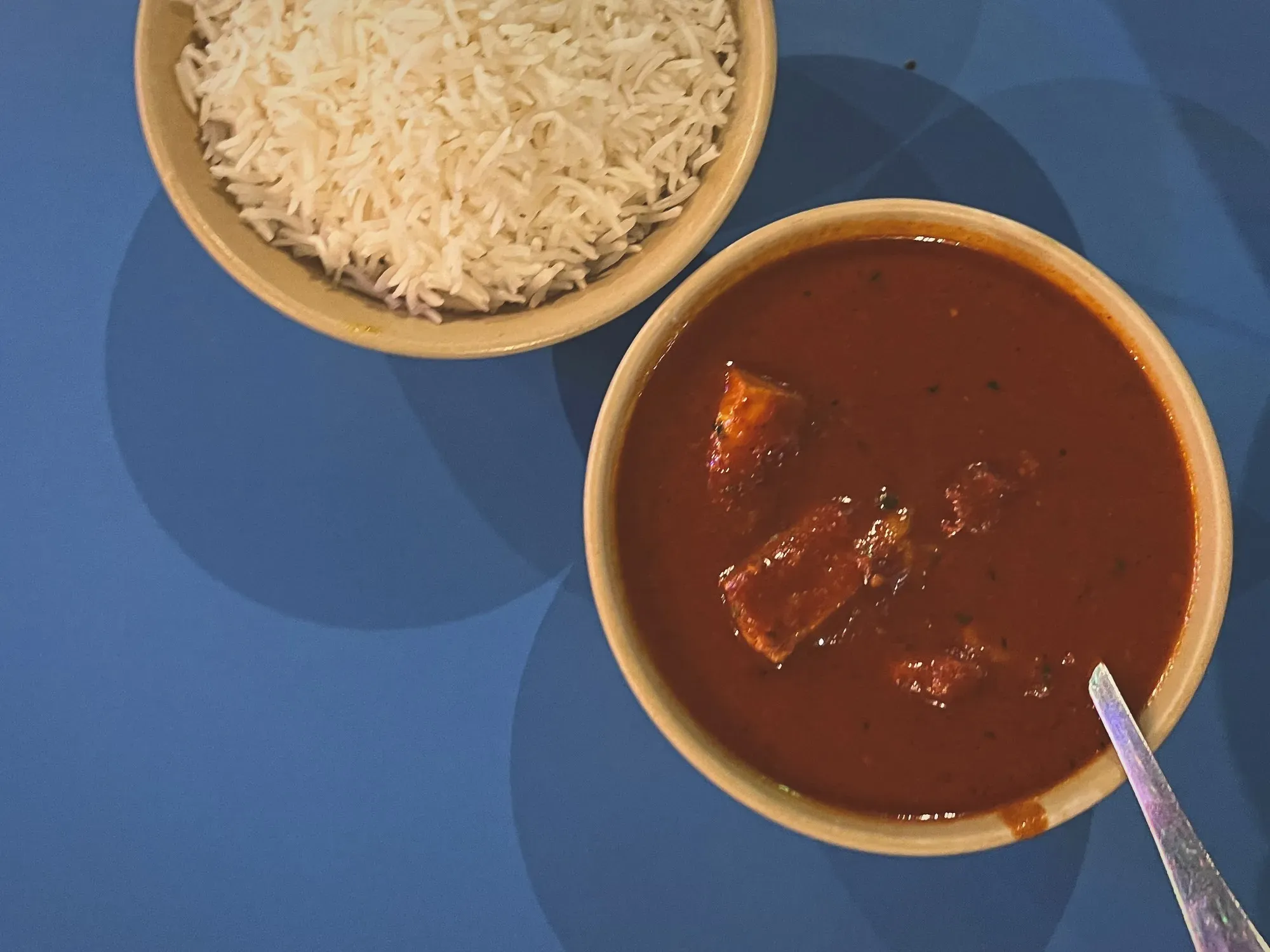
Vindaloo is a spicy and tangy curry dish that originated in Goa, a coastal state in Western India. The dish has its roots in Portuguese cuisine, as the name Vindaloo is derived from the Portuguese dish Carne de Vinha d'Alhos, which means meat marinated in vinegar and garlic. In India, the dish evolved to include a blend of spices and local ingredients such as chili peppers, tamarind, and cumin. The dish typically consists of meat (often pork) that is marinated in a mixture of vinegar, garlic, and spices before being cooked in a curry sauce. Vindaloo is known for its intense flavor and heat and is often served with rice or bread.
Pav Bhaji
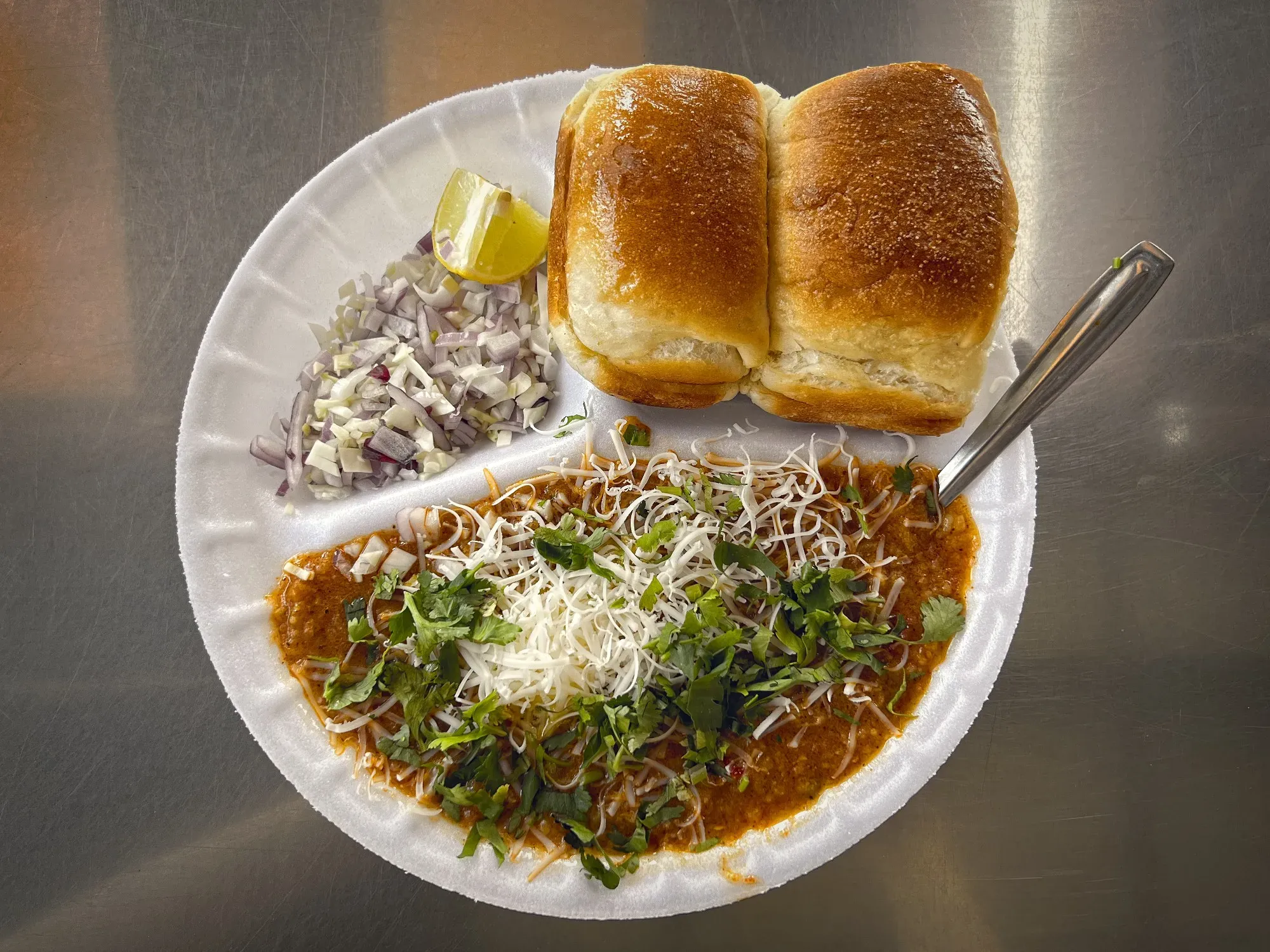
Pav Bhaji is a popular street food dish that originated in Mumbai, the financial capital of India. The dish consists of a spicy vegetable curry (known as bhaji) made with mashed vegetables such as potatoes, peas, tomatoes, and onions, that is then served with a soft bread roll called pav. The bhaji is cooked on a large griddle with a mix of spices, including cumin, coriander, turmeric, and chili powder. It is then topped with a dollop of butter and served with a squeeze of lime and chopped onions. Pav Bhaji is a staple of Mumbai's street food scene and has become a popular snack across India and around the world.
Vada Pav
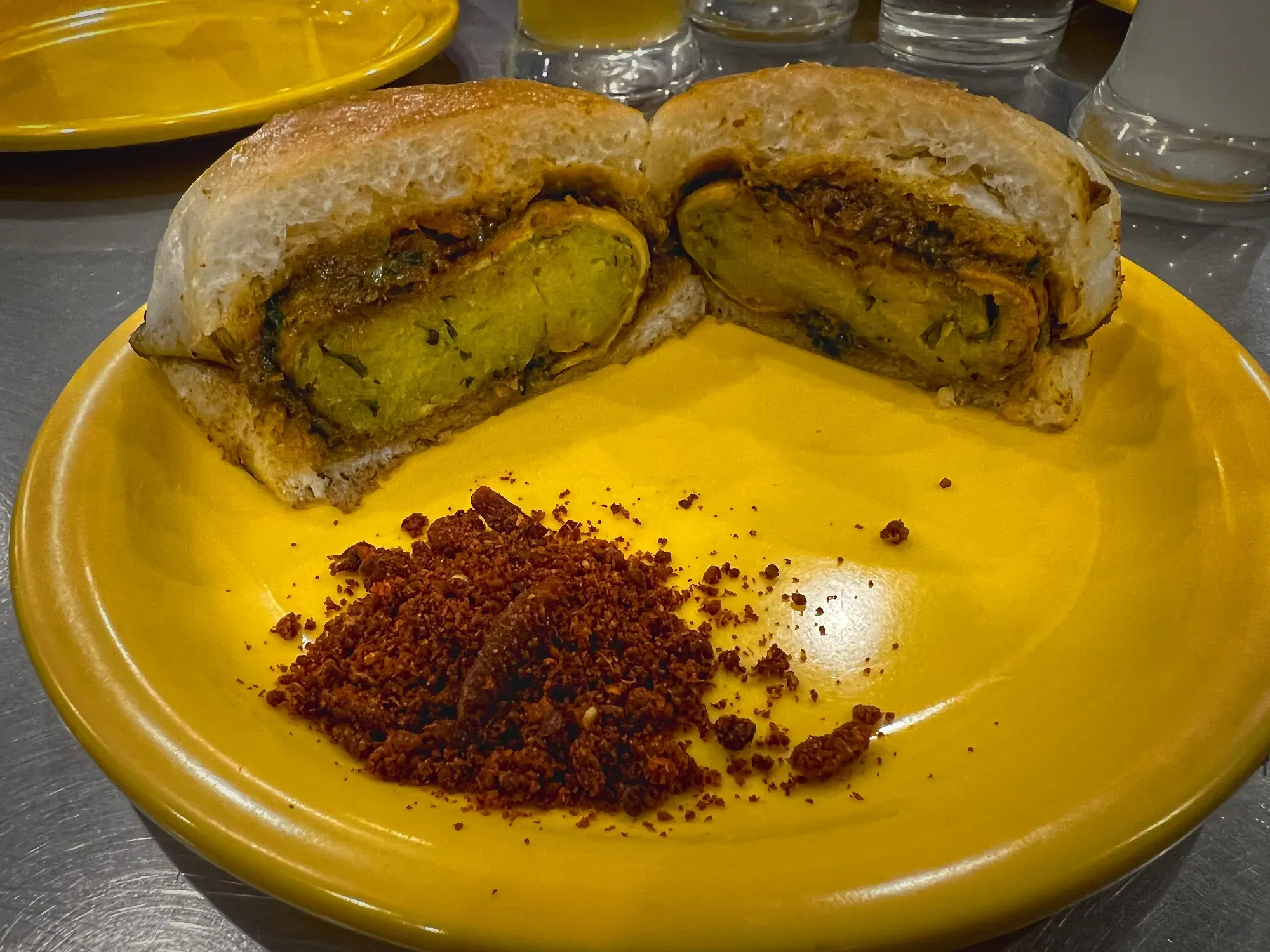
Vada Pav is a popular street food dish that originated in Mumbai, India. It consists of a deep-fried potato patty (known as vada) that is sandwiched between two slices of a soft bread roll called pav, along with a variety of chutneys, spices, and herbs. The vada is made by mixing mashed potatoes with a blend of spices, including cumin, turmeric, and chili powder, before being coated in a gram flour batter and deep-fried until crispy. The pav is typically toasted on a griddle with butter and garlic before being assembled with the vada and chutneys. Vada Pav is a quintessential Mumbai snack and a popular street food dish across India.
Thali
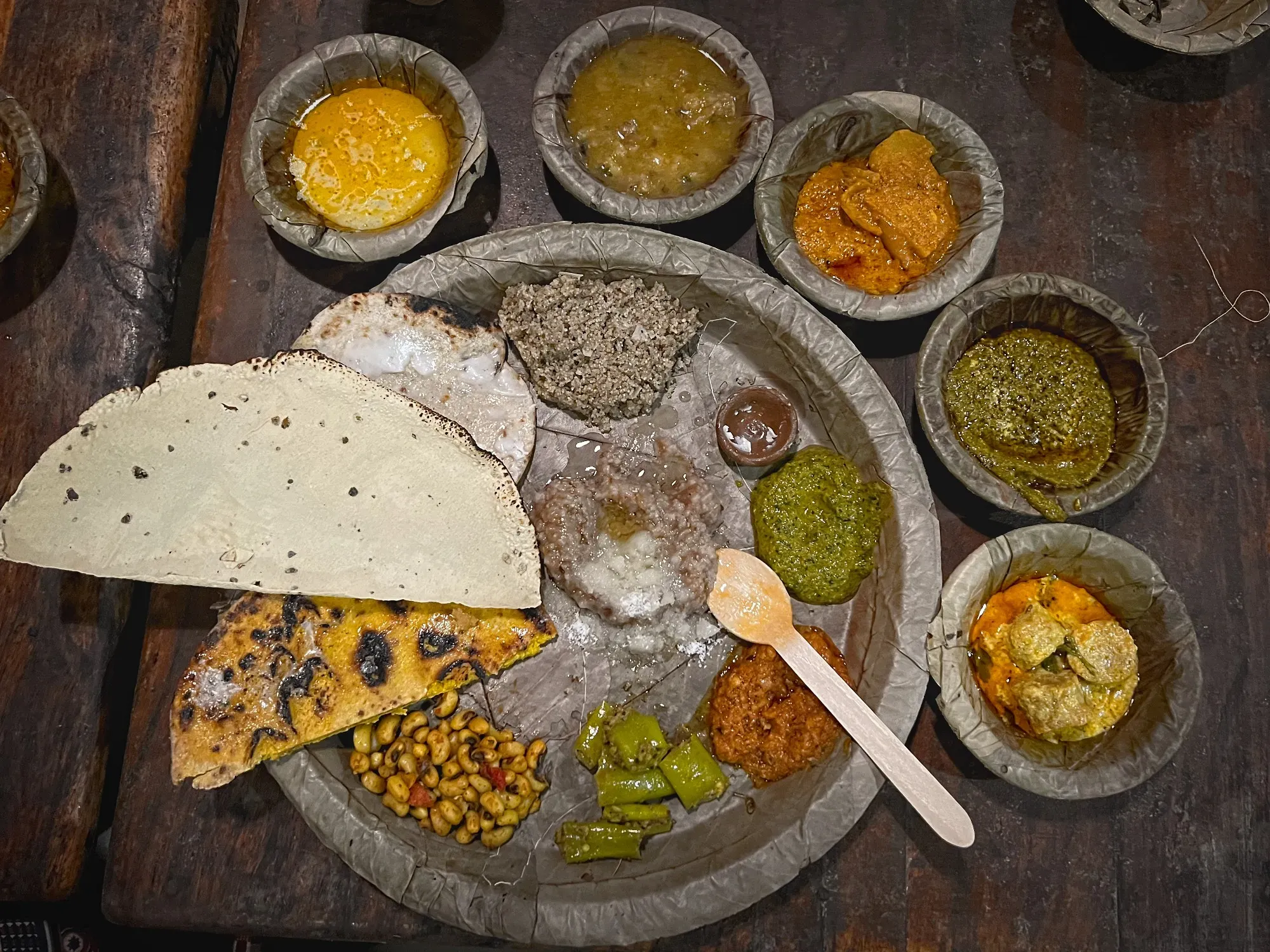
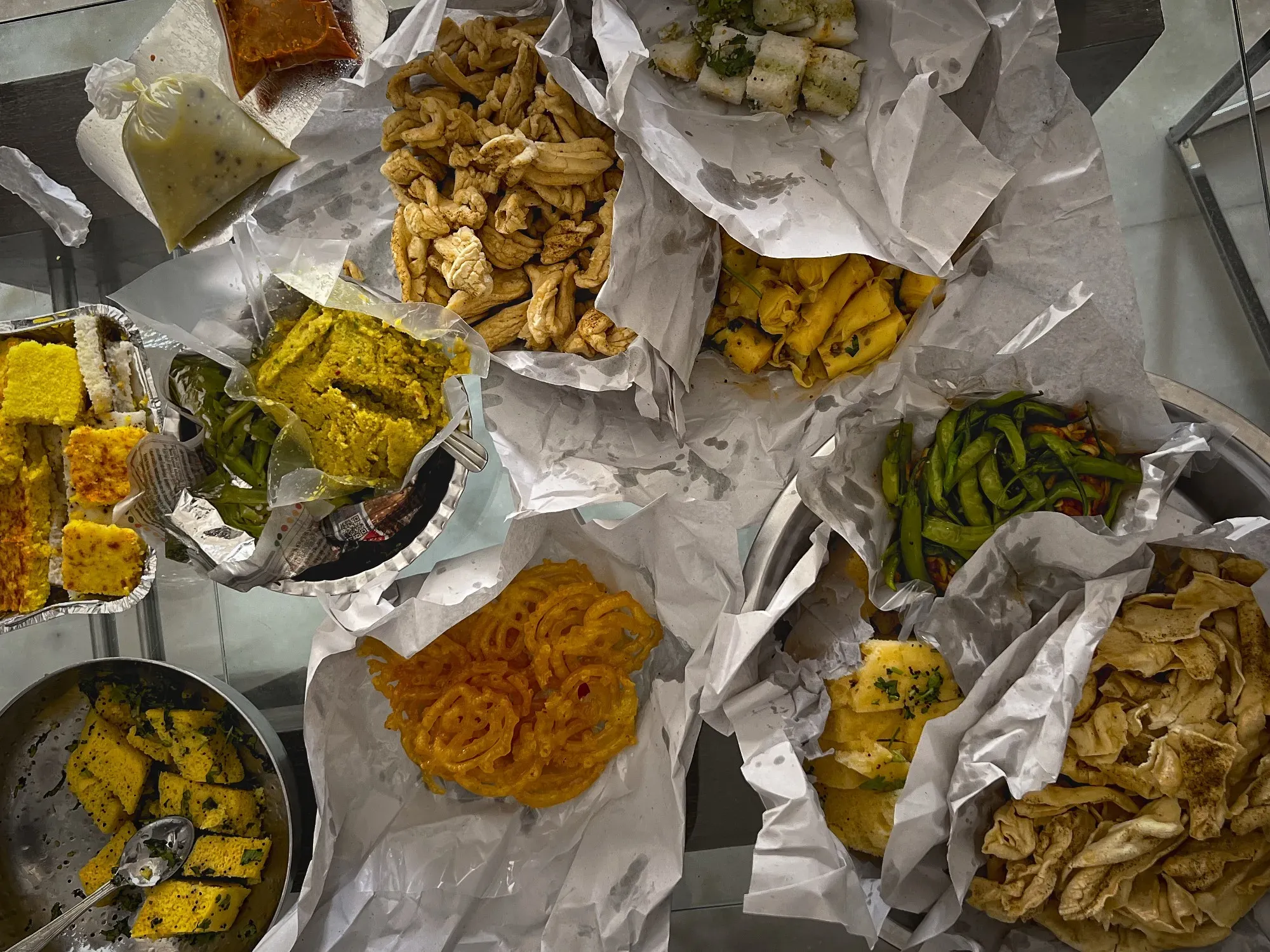
Thali is the Hindi word for “plate”. It is the term for a bunch of small bowls (katoris) of different regional dishes that together make up a meal (can also be a tray with build in compartments). The individual dishes that makeup a thali meal are based on the local region’s specialities. We cover them here because Western Indian Thali are some of the most famous variants, but this dish is applicable to every region throughout the country. It is an incredible way to try many of the local flavors of a place, and since many regions originally ate thali during festivals and celebrations, thali are often a mini feast to consume. While the dishes in a thali are extremely location dependent, some common themes can be found in what is served:
- A grain (rice or flatbread)
- Lentils
- Seasonal vegetables
- Chutneys
- Raita
- Pickles (aka, some local pickled speciality)
- Papad
- Chaats or regional snacks (see Gujarati Snacks)
Dhokla
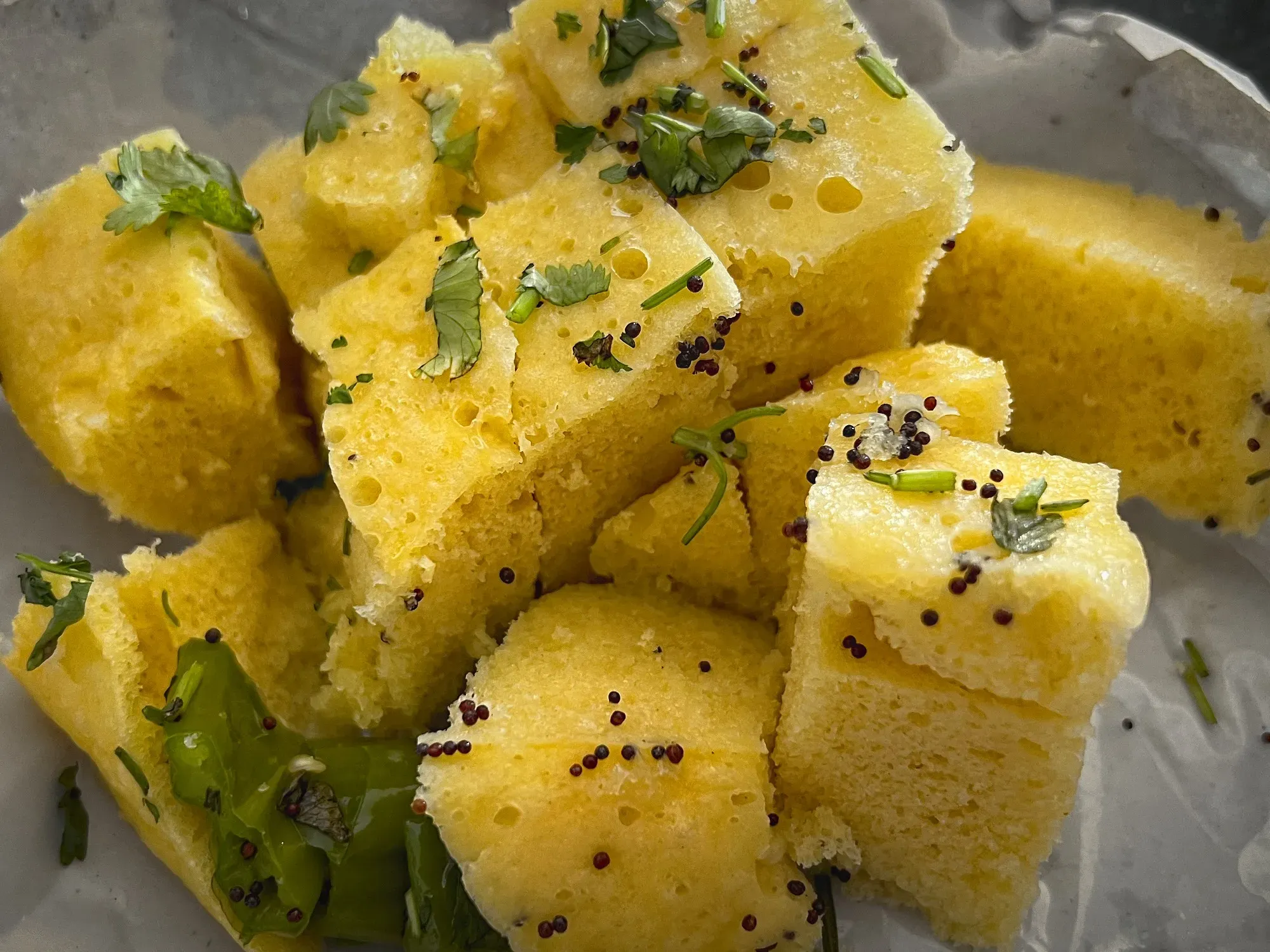
Dhokla is a popular snack originating from the Indian state of Gujarat. It is made by steaming a fermented batter made from rice flour, chickpea flour, and yogurt, along with a blend of spices and herbs such as turmeric, ginger, and green chilies. The steamed batter is then cut into small pieces and tempered with a mix of mustard seeds, curry leaves, and sesame seeds. Dhokla can come in many varieties: from a spongy texture (like the picture) to an almost cakey texture; it can be made with rava, or act as a the carbs to a chutney sandwich. It is typically served with a variety of chutneys such as mint, tamarind, and cilantro. Dhokla is a popular snack across India and is also enjoyed as a breakfast item or a light meal.
Regional-Specific Shoutouts
Goan Fish Curry
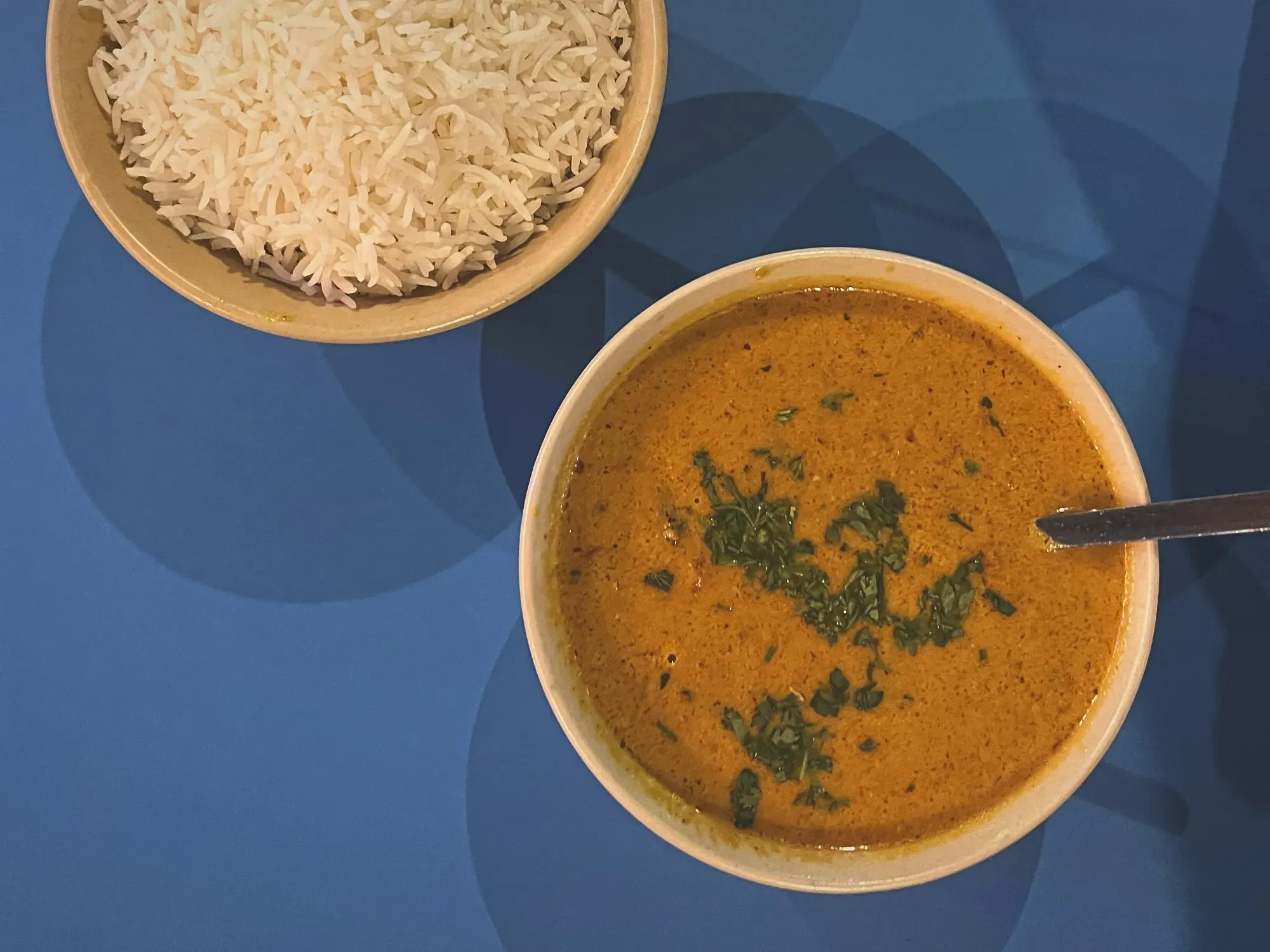
Goan Fish Curry is a popular seafood dish from the coastal state of Goa in India. It is made with a variety of fish such as kingfish, pomfret, or mackerel, that are simmered in a tangy and spicy coconut-based curry. The curry is made by blending grated coconut with spices like cumin, coriander, and turmeric, along with tamarind and red chili powder, to create a flavorful paste. The fish is then cooked in this paste along with onions, tomatoes, and green chilies, until it is tender and fully cooked. Goan Fish Curry is often served with steamed rice or bread, and is a staple of Goan cuisine.
Xacuti
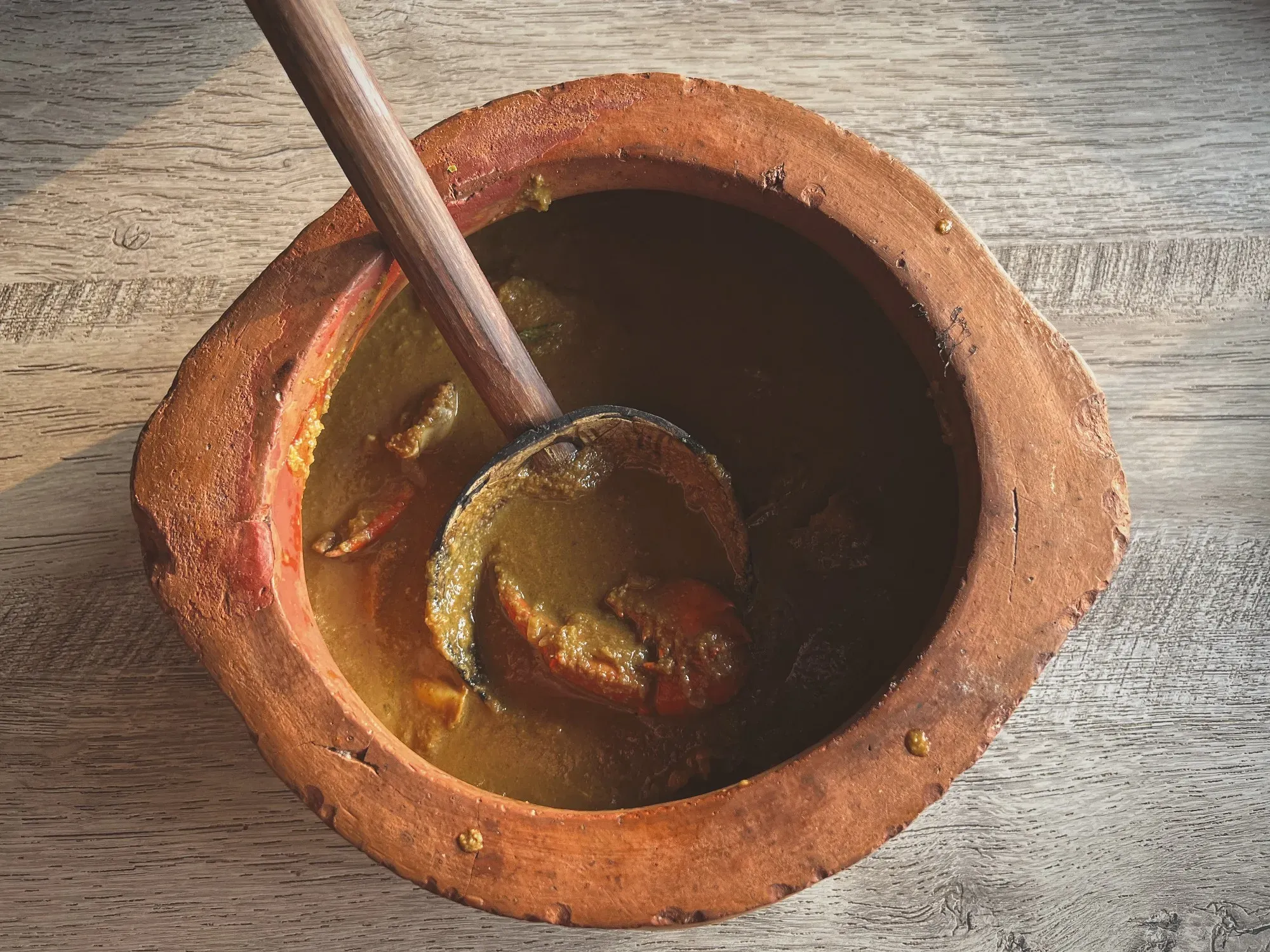
Xacuti is a spicy and flavorful Goan dish made with meat (often crab) cooked in a coconut-based curry. It originated in the coastal state of Goa, India, which is known for its unique cuisine that combines Indian, Portuguese, and local flavors. The dish is made with a blend of aromatic spices such as red chilies, coriander, cumin, black pepper, and turmeric, which are toasted and ground to make a fragrant masala paste. The meat is then cooked in the masala paste along with onions, tomatoes, and coconut milk, which gives the dish its creamy and rich texture. Xacuti is typically served with steamed rice or crusty bread, making it a delicious and satisfying meal.
Balchão
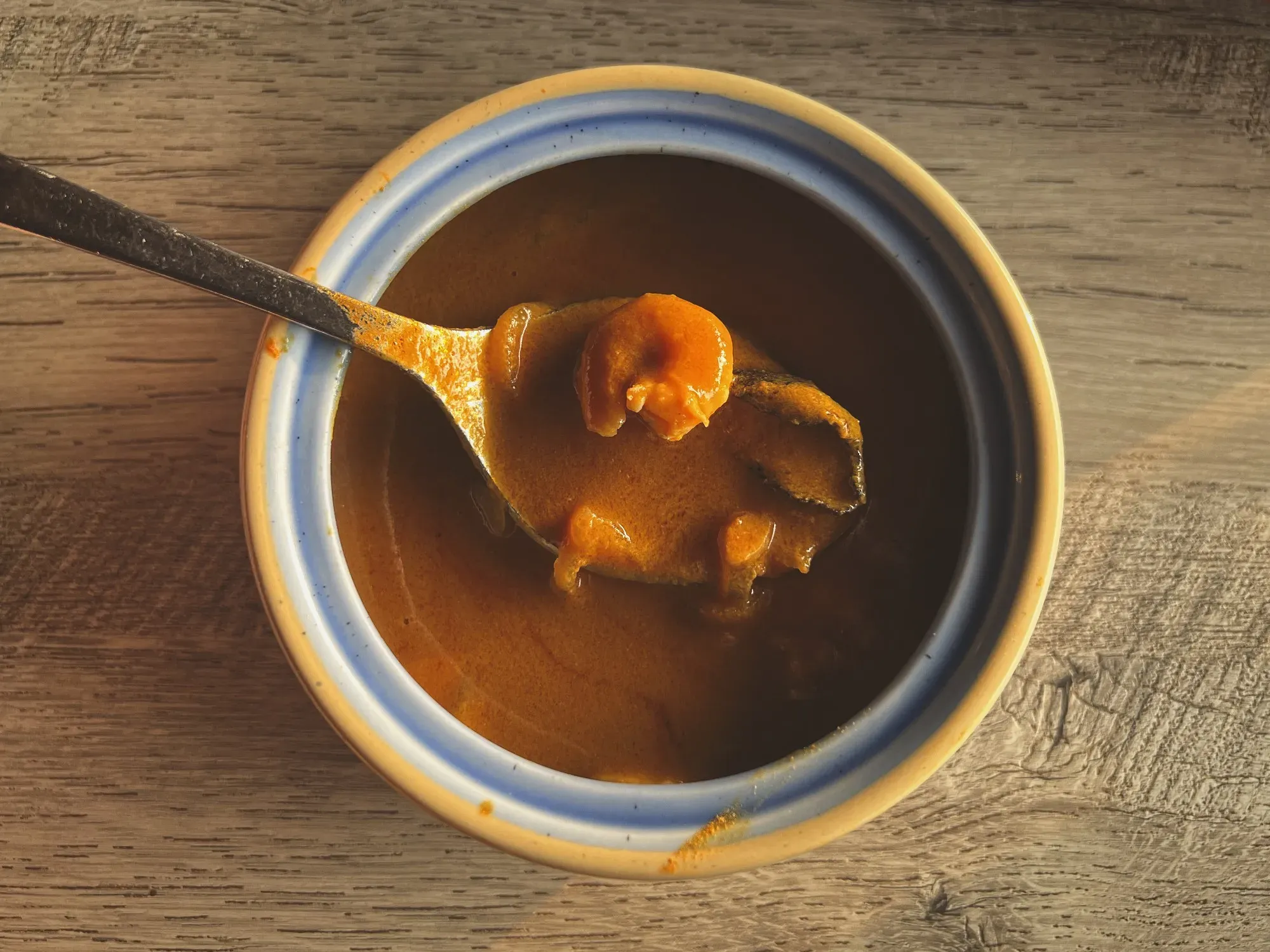
Balchão is a popular spicy seafood dish that originated in the Indian state of Goa, a former Portuguese colony. It is typically made with small shrimp or fish, which are marinated in vinegar, salt, and turmeric before being cooked in a spicy tomato and onion-based sauce that is flavored with garlic, ginger, cumin, and other spices. The dish has a tangy, fiery flavor and is often served with rice or bread. Balchão has become popular in other parts of India as well as in the neighboring country of Sri Lanka, and has also been adapted in other countries with a strong Portuguese influence, such as Brazil and Mozambique.
Frango à Cafreal
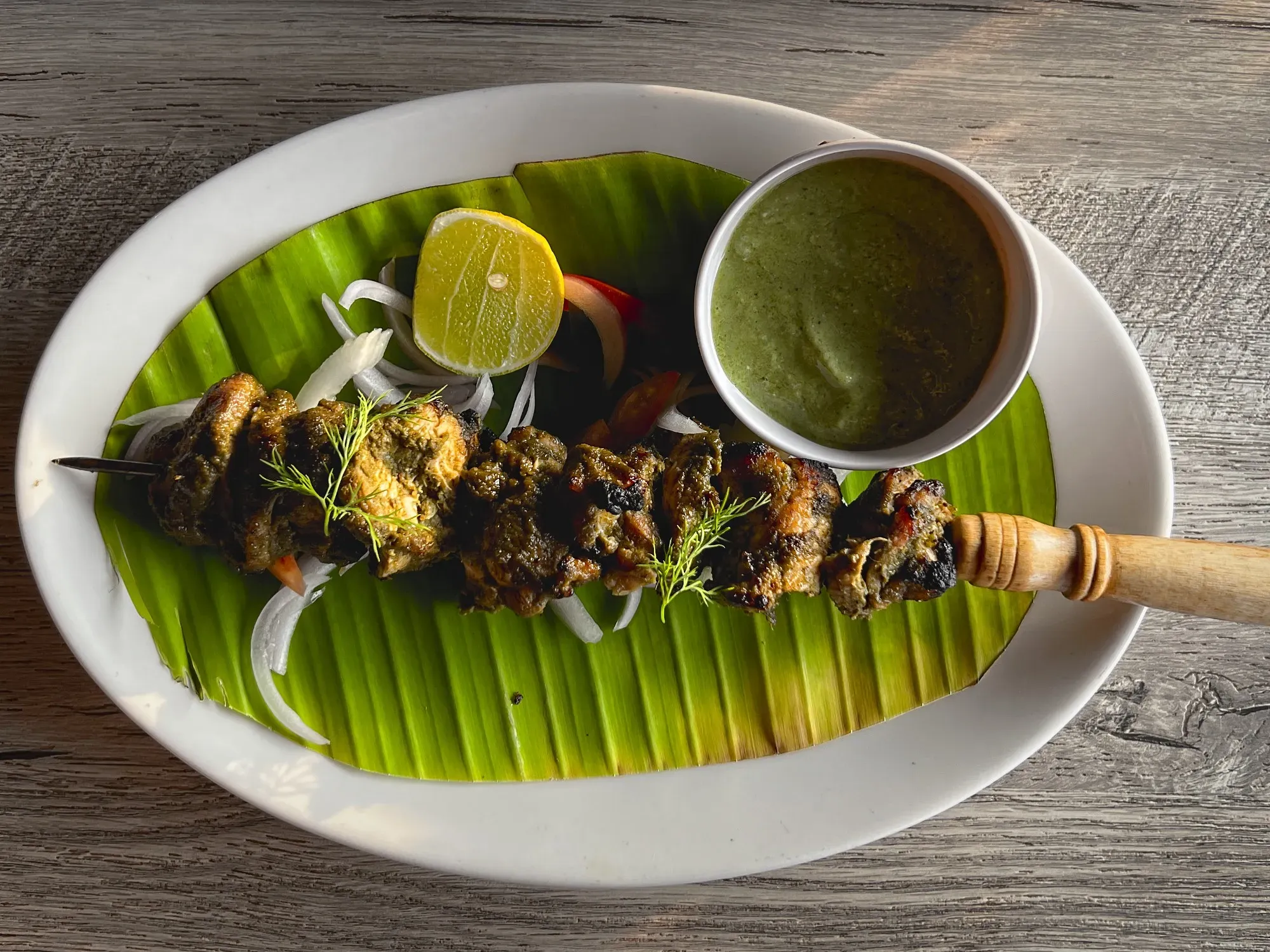
Frango à Cafreal is a spicy chicken dish that originated in the Indian state of Goa, which was heavily influenced by Portuguese culture. The dish features chicken marinated in a blend of spices, including coriander, cumin, turmeric, garlic, and ginger, as well as vinegar, which is a common ingredient in Goan cuisine. The chicken is then cooked on a grill or in a pan until it is tender and flavorful. Frango à Cafreal is often served with a side of fries or rice, and it is a popular dish in many Goan restaurants and households. Its spicy, tangy flavor profile makes it a favorite among those who enjoy bold, flavorful dishes.
Misal Pav / Misal Pao
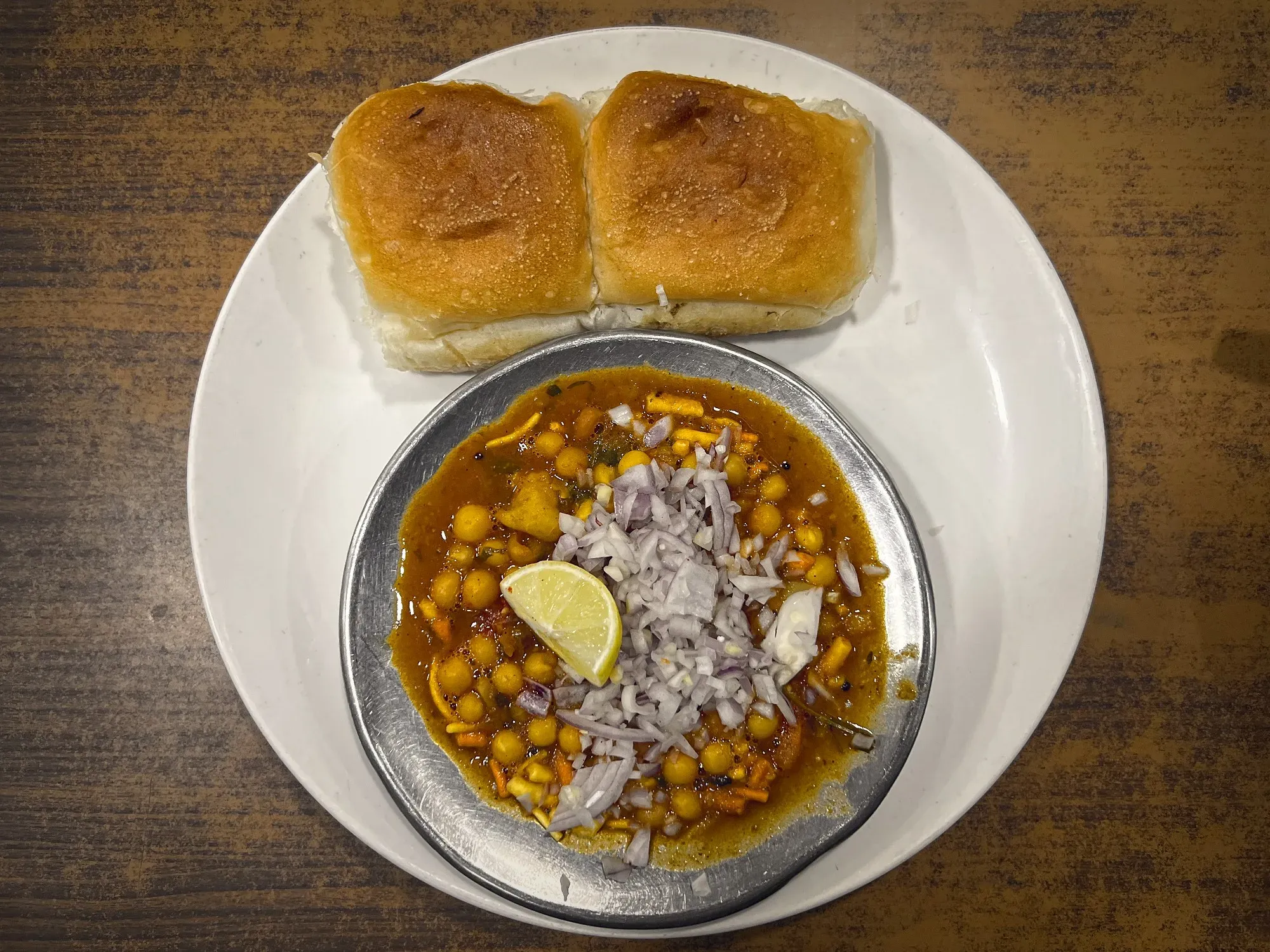
Misal Pav is a popular street food dish from the Indian state of Maharashtra, particularly in the city of Pune. It consists of a spicy gravy made with sprouted beans, peas, and lentils, known as "misal," which is topped with farsan, a mix of crunchy toppings like sev, chiwda, and peanuts. The dish is typically served with pav, a type of bread roll, that is used to mop up the flavorful gravy. The spicy and tangy flavors of the Misal Pav are balanced by the sweetness of the farsan and the softness of the bread. Misal Pav is a staple of Maharashtrian cuisine and is enjoyed as a hearty breakfast or snack.
Poha
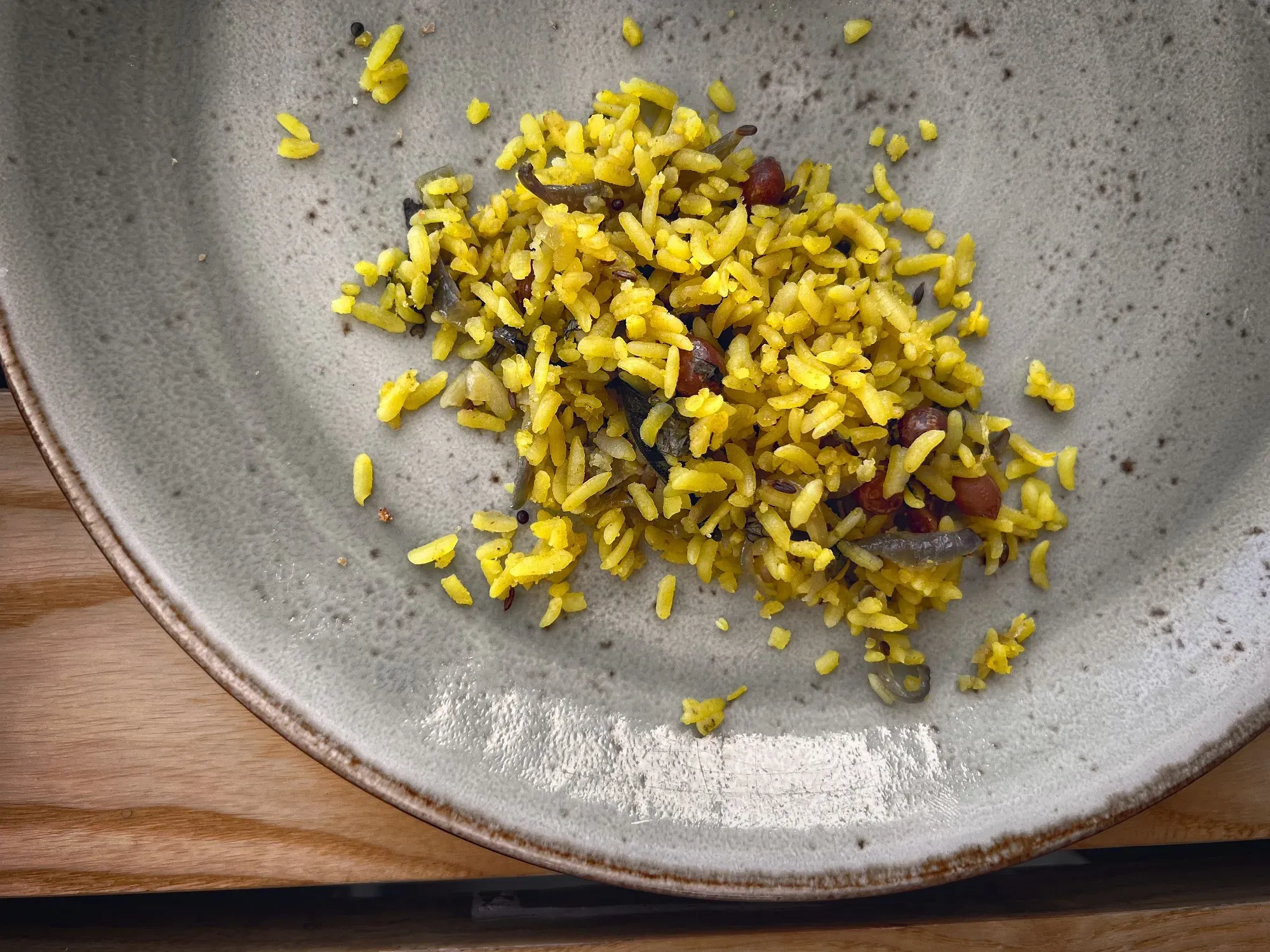
Poha is a popular Indian breakfast dish made from flattened rice flakes that have been pre-soaked, then stir-fried with various spices, vegetables, and sometimes peanuts. The dish is known for its light, fluffy texture and savory flavor. Originating from the Maharashtra region of India, Poha is commonly eaten as a quick and easy breakfast dish. It is also a popular street food item and can be found in many parts of India.
Gujarati Snacks
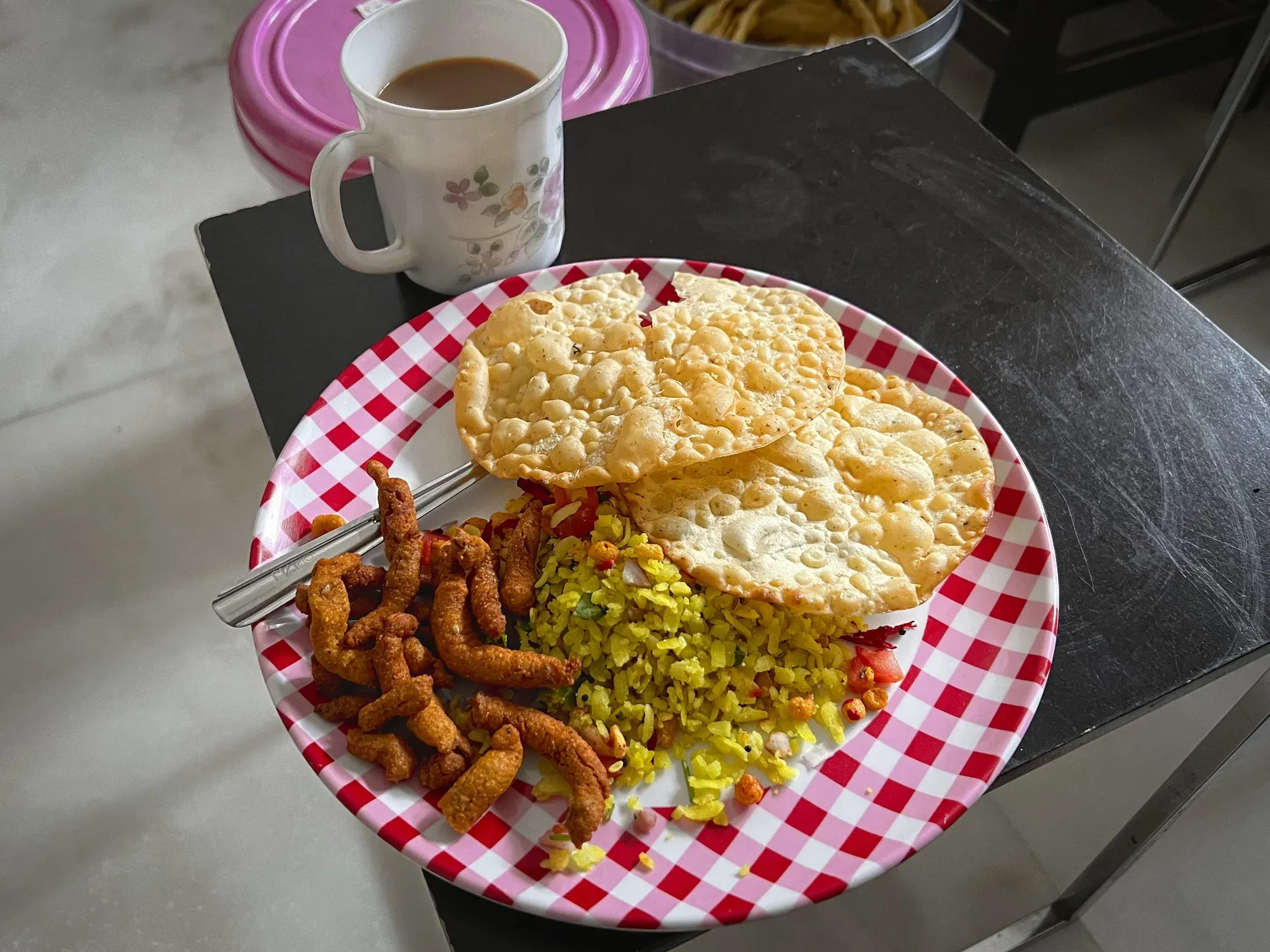
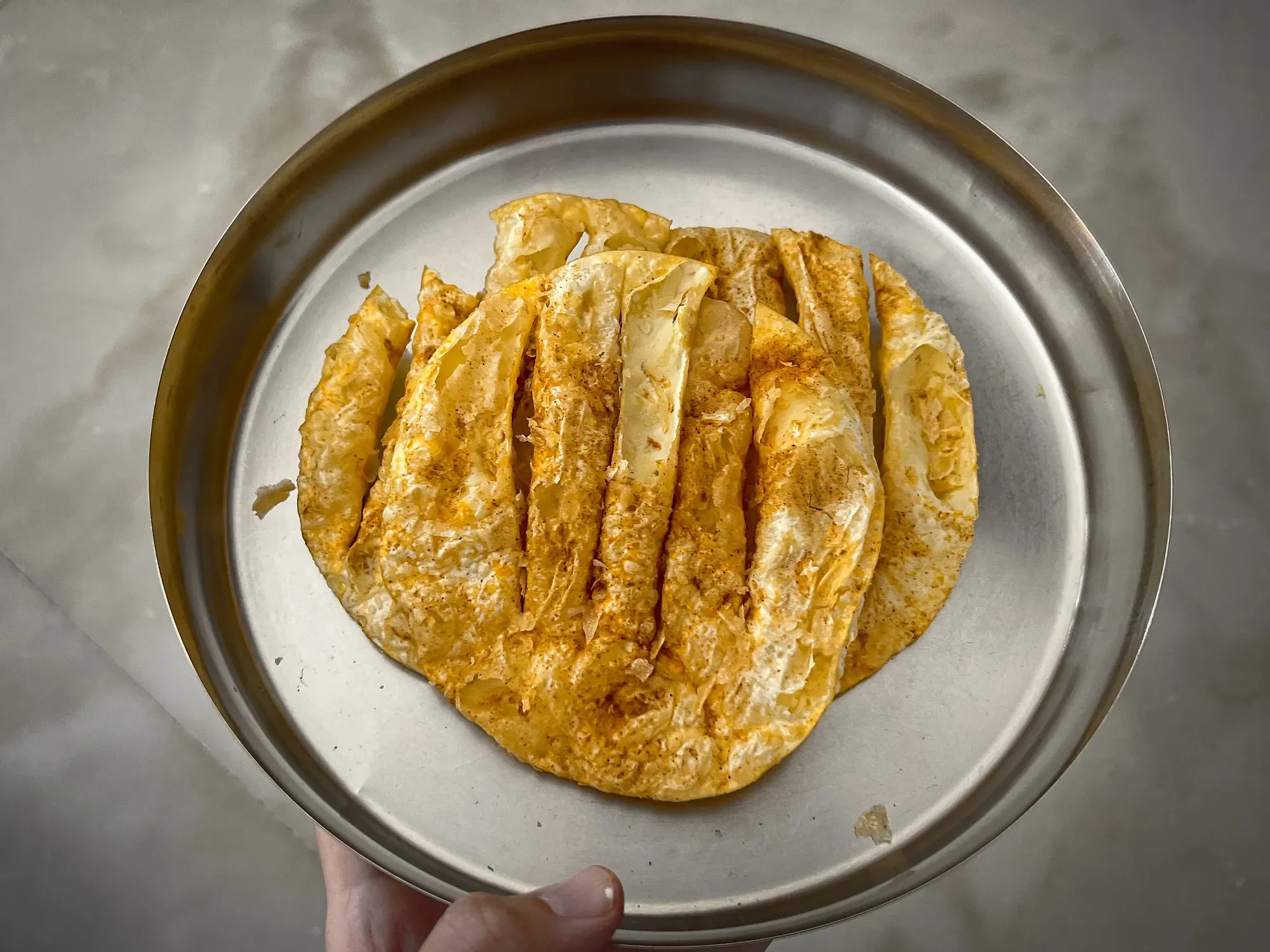
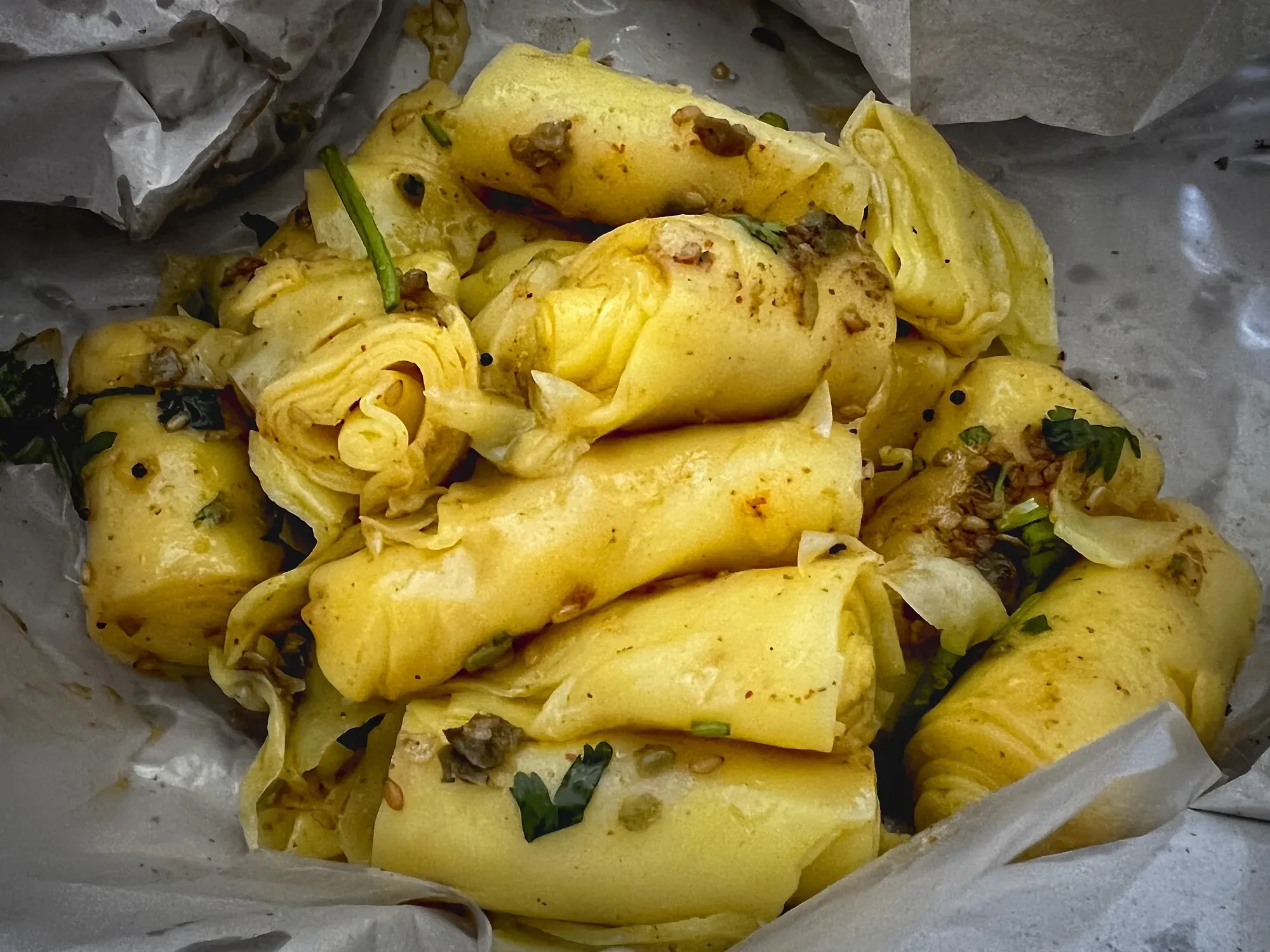
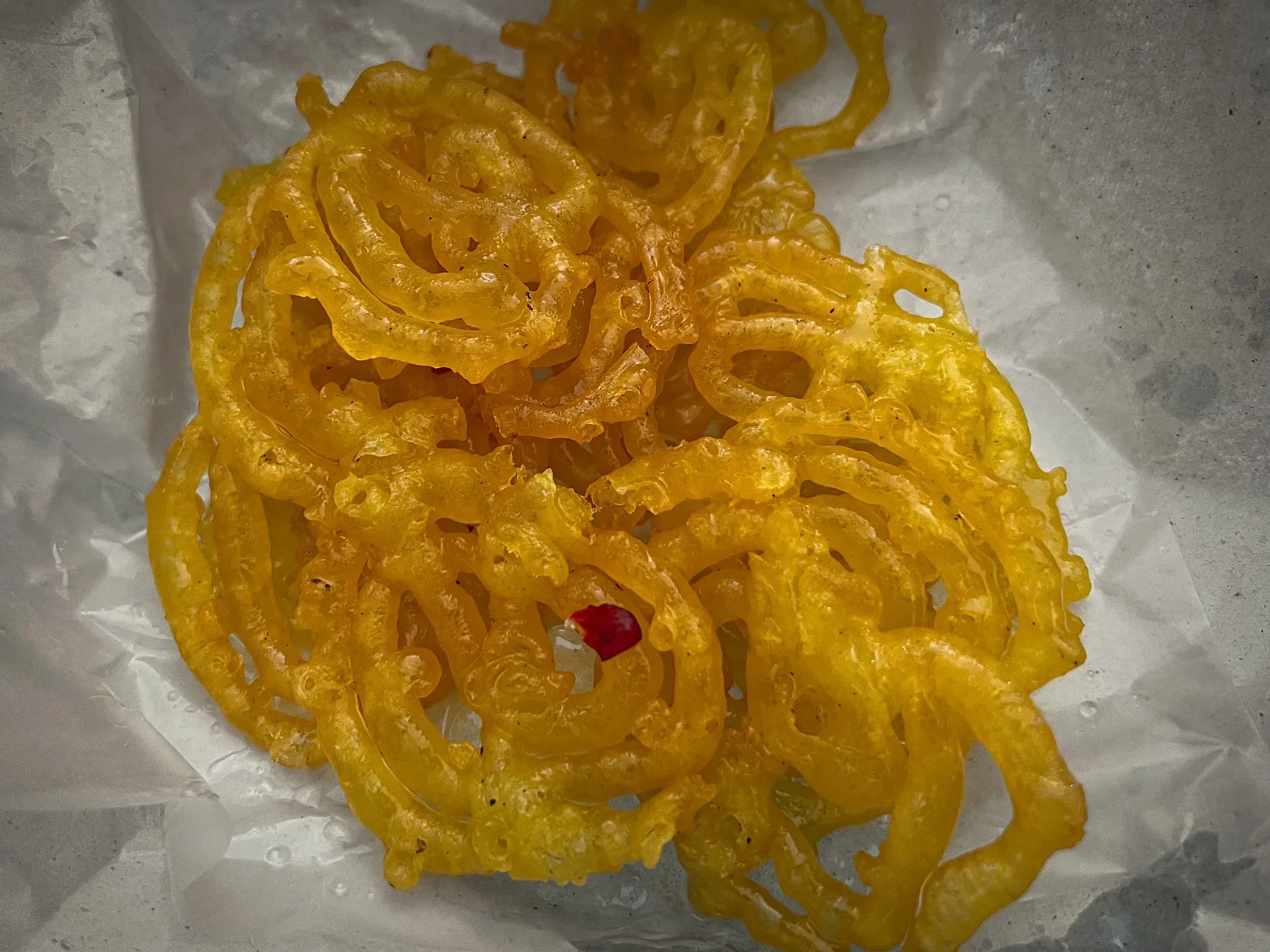
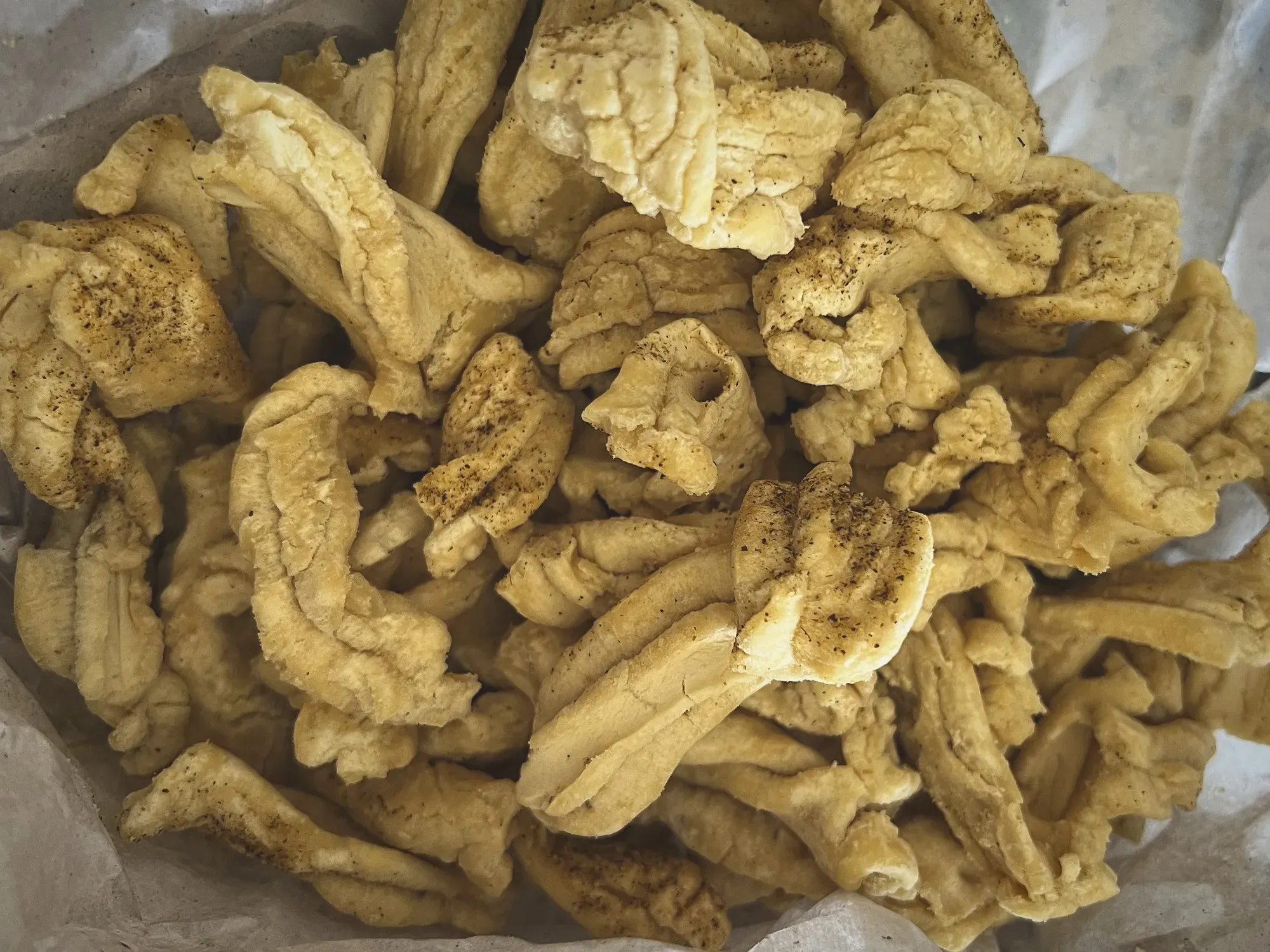
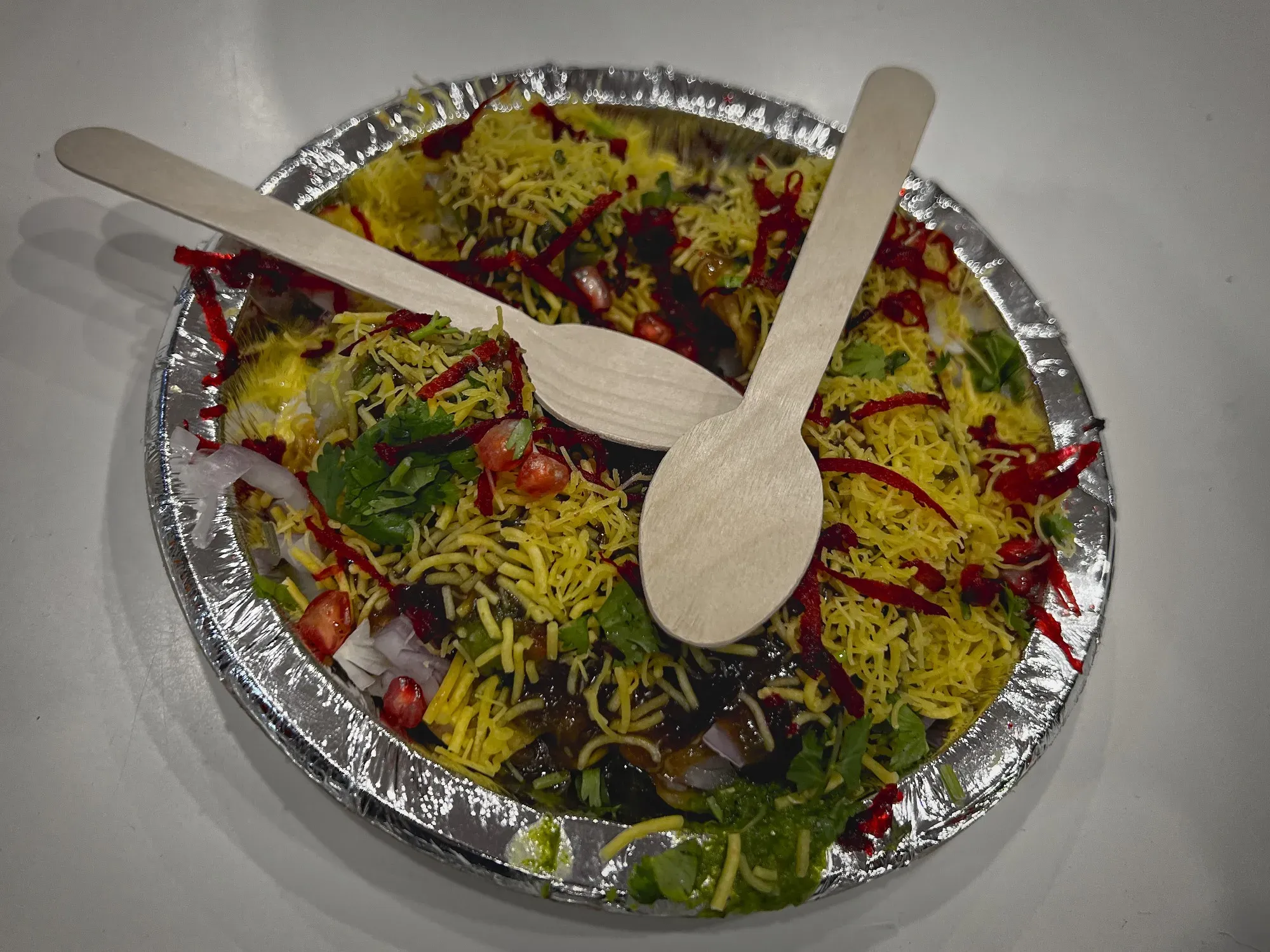
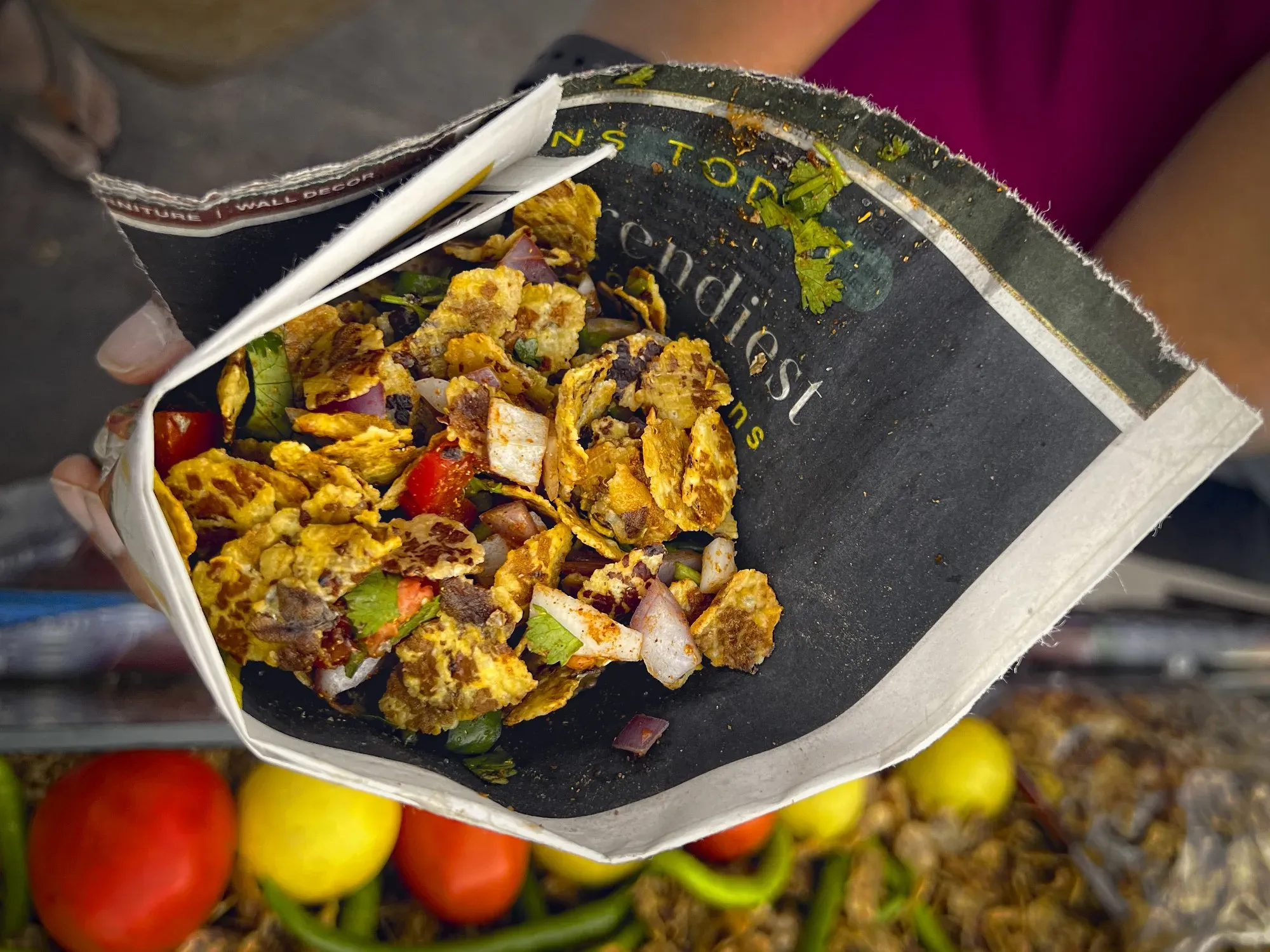
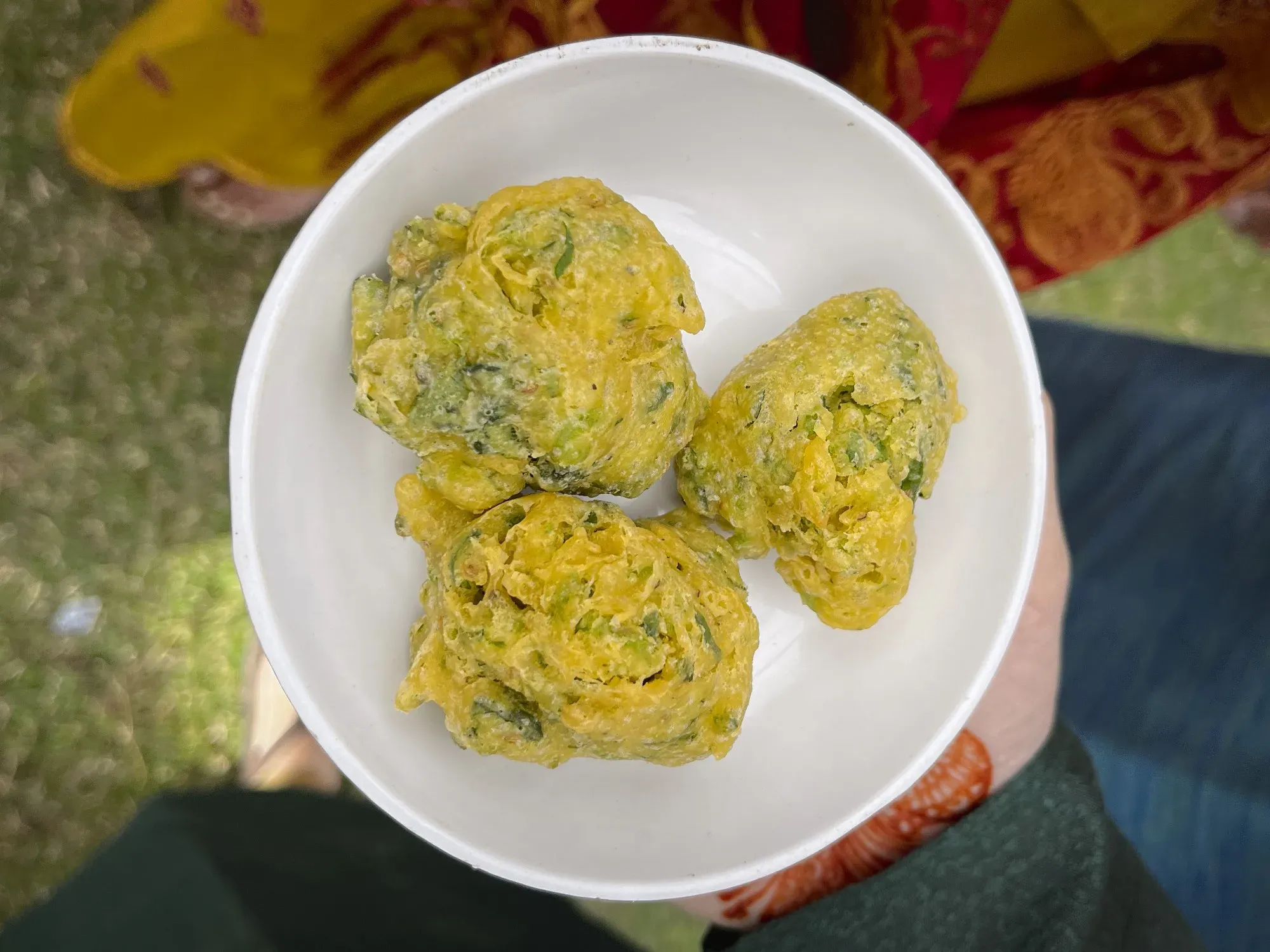
Gujarati snacks are extremely popular in the western Indian state of Gujarat. Gujarati snacks are often sold by street vendors in small food stalls or carts and is enjoyed as a light snack or a full meal. Within Gujarati snacks itself, Gujarati Farsan is a term that describes a special subsection of Gujarati snacks:
- Khandvi: A popular Gujarati snack made with gram flour and buttermilk, rolled into thin bite-sized rolls, topped with toasted mustard seeds, cilantro, and coconut.
- Jalebi: A sweet, spiral-shaped Indian dessert made with deep-fried flour and soaked in sugar syrup.
- Fafda: A salty and crunchy snack made from gram flour dough, typically served with a khadi chutney.
- Chorafali: Another popular Gujarati snack made with gram flour, baking soda, and spices, often eaten during festivals.
- Dhokla: (see above)
- Mathia: a large, flat, round cracker made from a mixture of flour, spices, and oil. It is often plays a central role in food for Diwali.
- Ganthia: Deep-fryed dough knots made from chickpea flour and spices.
- Gota: Fried balls of methi (fenugreek), often served with chutney.
The list of Gujarati snacks can go on for a long time, but here are some other snacks and chaat that make up the most popular items:
- Dhabeli: A popular Gujarati street food made with a potato and vegetable filling served in a bun.
- Sev Usal: A spicy dish made with chickpeas, sev (crunchy noodles), and vegetables, typically eaten as a snack or light meal.
- Chana chor: A spicy chaat made from fried chickpeas seasoned with various spices.
- Sevpuri: A popular Indian street food chaat made by topping crispy, hollow puris with a mixture of chopped onions, tomatoes, chutneys, and spices. It is often served with a tangy tamarind sauce and garnished with sev, a crispy noodle made from chickpea flour.
Dal Dhokli
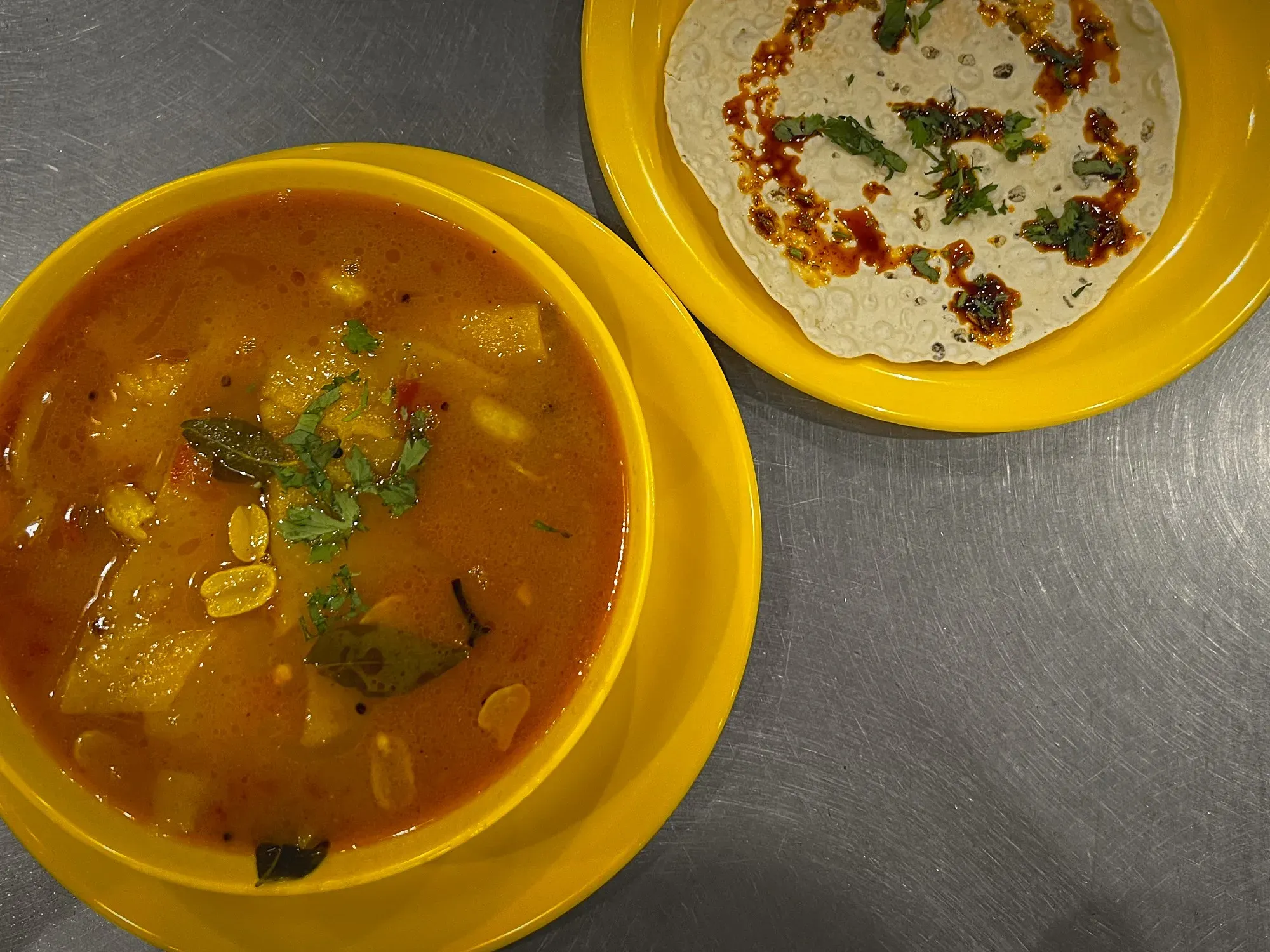
Dal Dhokli is a traditional Indian dish, popular in the state of Gujarat. It is a hearty one-pot meal consisting of boiled wheat flour dumplings called "dhokli" cooked in a spicy lentil soup or "dal". The dumplings are typically flavored with a mix of spices and often have vegetables like spinach or fenugreek leaves mixed in. The dal is usually made with toor dal or pigeon peas, and seasoned with a blend of aromatic spices like cumin, mustard seeds, turmeric, and garam masala.
Bombay Duck
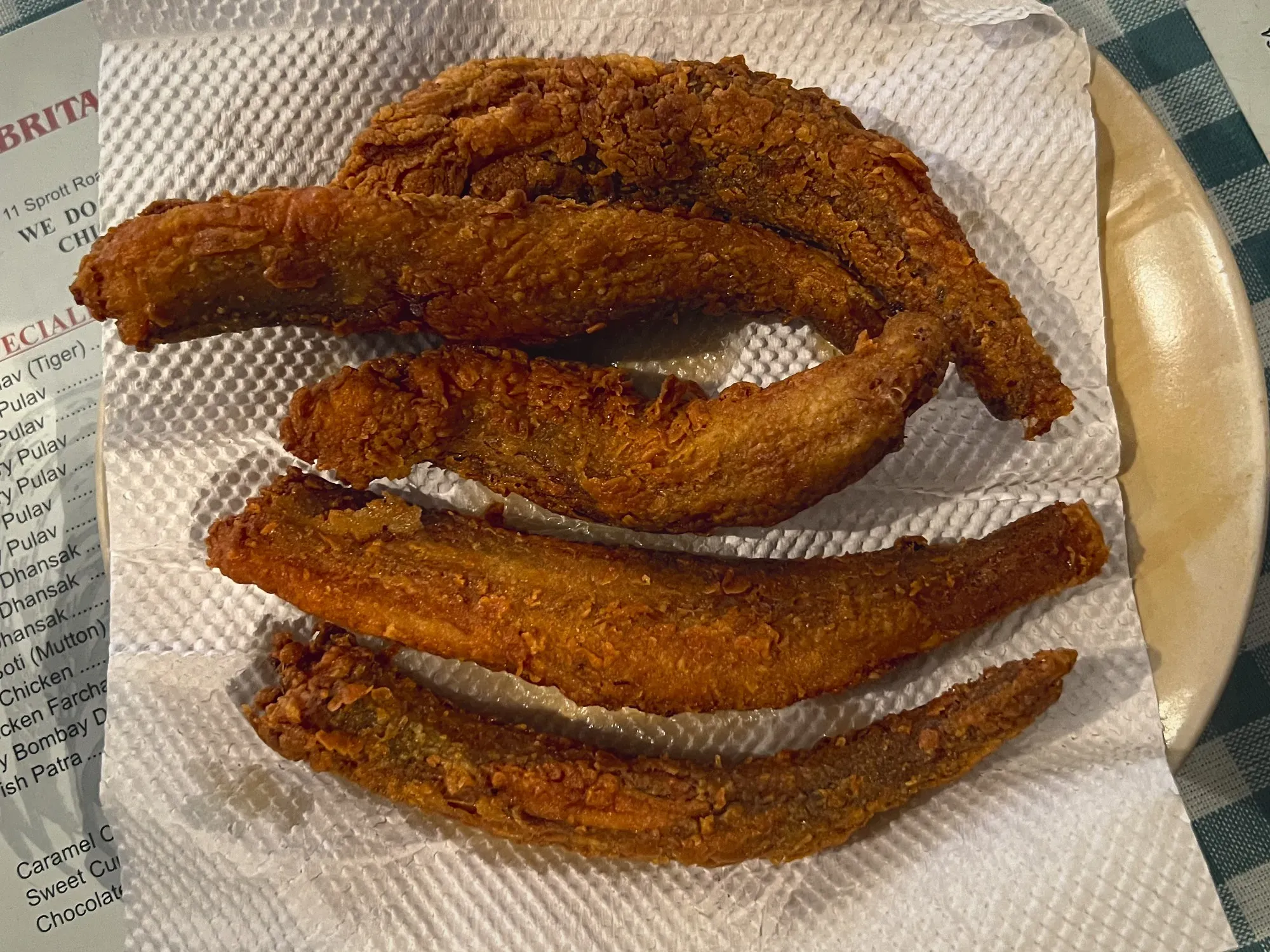
Contrary to its name, Bombay Duck is not a duck, but a type of fish that is commonly found in the Arabian Sea, particularly off the coast of Mumbai (formerly known as Bombay), a city on the western coast of India. The fish is small and has a distinct pungent aroma, which is said to be reminiscent of the city's bustling markets. It is typically prepared by marinating in a mix of spices and then sun-drying for several days. The dried fish is then fried and served as a crispy snack or as a side dish with rice and curry. Bombay duck has been a popular delicacy in Mumbai for generations and is a must-try for seafood lovers.
Bebinca
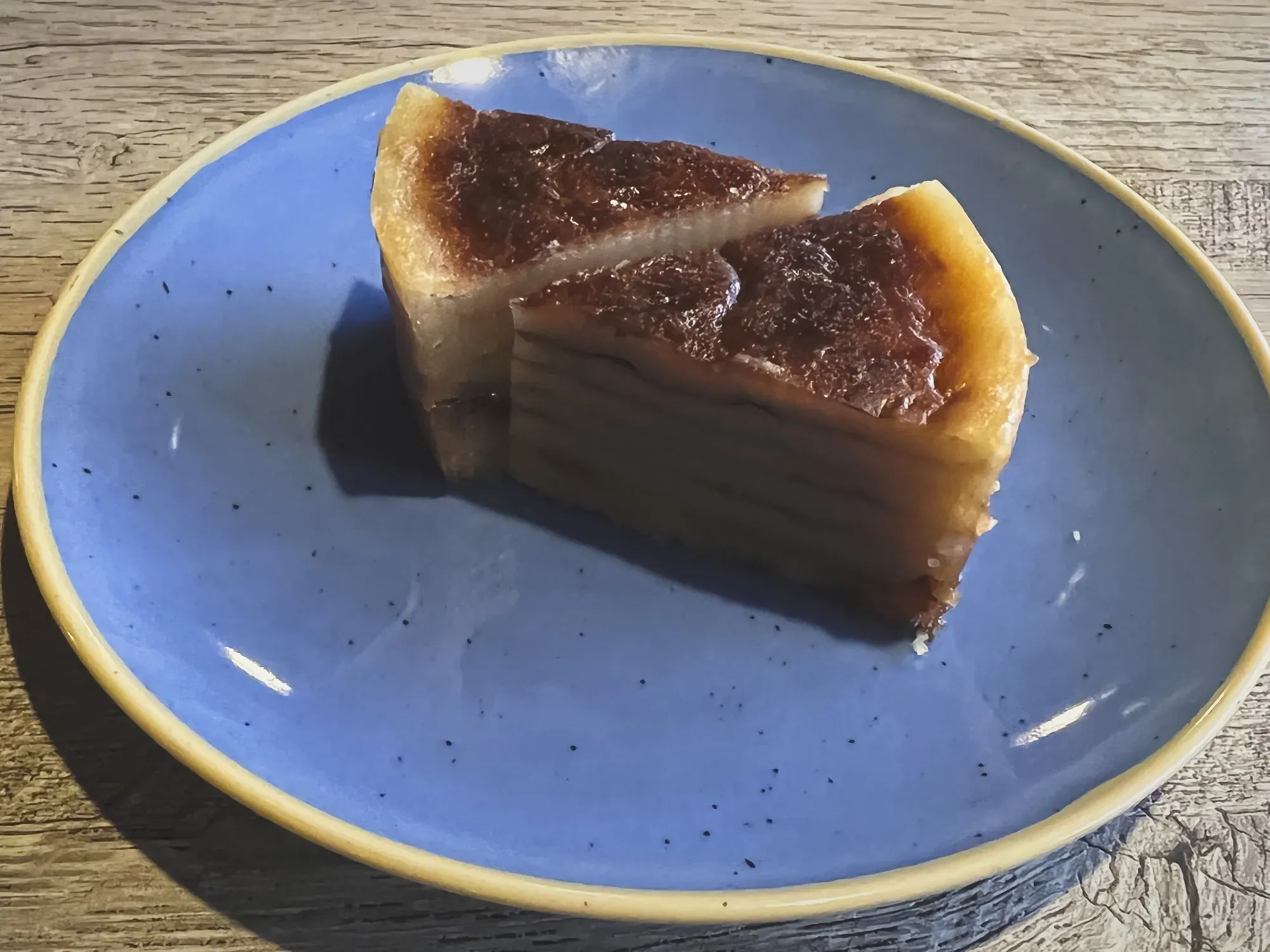
Bebinca is a popular dessert from the Indian state of Goa, located on the western coast of the country. It is a multi-layered cake made with coconut milk, sugar, and egg yolks. The batter is poured into a baking dish, layer by layer, and baked until it is golden brown and set. The result is a delicious, moist, and sweet cake with a hint of caramelization. Bebinca is a popular dessert during celebrations and festivals in Goa and is often served with vanilla ice cream or fresh fruit. It is believed to have originated in the Portuguese-influenced region of Goa and has since become a beloved sweet treat across India.
Shrikhand
Shrikhand is a traditional Indian dessert made from strained yogurt, flavored with saffron, cardamom, and sugar. The dish originated in the western Indian state of Gujarat, where it is commonly served as part of festive meals and celebrations. The yogurt is hung in a cloth to drain out the whey and then mixed with sugar and spices. It is served chilled and can be garnished with chopped fruits and nuts. Shrikhand has a creamy and smooth texture, and its sweetness is balanced by the aromatic spices. It is a popular dessert across India and is also enjoyed in neighboring countries such as Pakistan and Bangladesh.
Gudpak
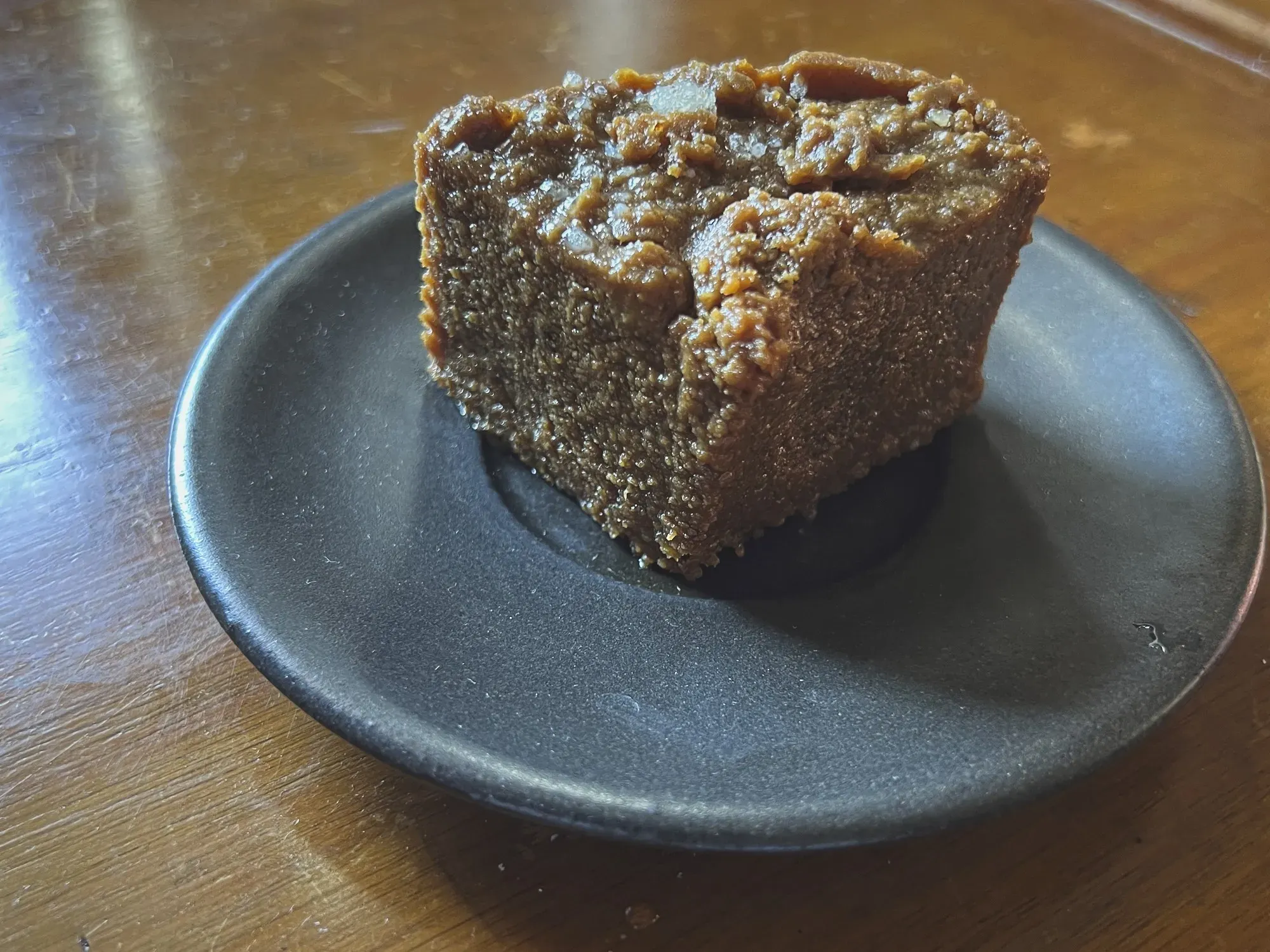
Gudpak is a traditional sweet dish that originated in the Indian state of Gujarat. It is made from roasted and ground besan (gram flour), ghee, and sugar, which are mixed together with a variety of nuts and spices. The mixture is then pressed into small molds and left to cool until it hardens. Gudpak is known for its rich and nutty flavor, as well as its melt-in-your-mouth texture. It is a popular dessert that is often enjoyed during festivals and special occasions in Nepal and Gujarat, and is also sold in sweet shops and markets throughout the region.
List of Other Things to Try:
- Handvo: A vegetable cake made with a blend of lentils, rice, and vegetables, typically steamed or baked.
- Khichu: A savory dough made from rice flour, cumin, and salt, often served as a snack or with a meal.
- Khichdi: A popular Indian comfort food made with rice, lentils, turmeric, and ghee, often seasoned with spices. Sometimes served with Gujarati Khadi.
- Aamras: A sweet and tangy mango pulp, often served as a dessert or with puris.
- Zunka (Jhunka) Bhakri: A spicy and savory dish made with chickpea flour and vegetables, served with Indian flatbread.
- Bhelpuri: A popular street food snack made with puffed rice, vegetables, chutneys, and spices.
- Thepla: A soft and thin Gujarati flatbread made with wheat flour, spices, and sometimes vegetables, especially methi (fenugreek).
- Baraf No Golo: A popular Gujarati dessert in the hot summer months. The name literally means "ice balls" in Gujarati, and that's exactly what it is - small balls of flavored ice served with sweet syrup.
- Modak: A sweet dumpling typically made during the Indian festival of Ganesh Chaturthi, filled with coconut, jaggery, and spices.
- Gol Papdi: A sweet and crumbly dessert made with flour, ghee, and sugar, often flavored with cardamom and nuts.
- Mohan Thai: A sweet and rich milk-based dessert made with saffron, vermicelli, and nuts, typically served chilled.
- Gujarati Kadhi: A yogurt-based curry typically made with chickpea flour, vegetables, and spices, often served with rice.
- Chaas: A refreshing yogurt-based drink often flavored with cumin, mint, and other spices, popular in India during hot weather.
- Parle G: A popular brand of Indian biscuits known for their sweet and crunchy texture.
Resources
Restaurant Recommendations
Due to staying with family during our much of our time in Western India, we did not explore as many restaurants as usual. So for recommendations we can just confirm two famous tourist restaurants are indeed worth a visit: Souza Lobo in Goa and the Britannia & Company Restaurant in Mumbai. The crab Xacuti at Souza Lobo is fantastic and the view is great. Britannia & Company Restaurant prepares some great biryani specialties, and supposedly has one of the best Bombay Duck in the city - we for sure enjoyed it.
To see an extensive list of restaurant recommendations in India, check out the Restaurants page to see a map of our top recommendations for Asia as well as the database with details on restaurants from all around the world.








